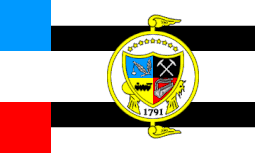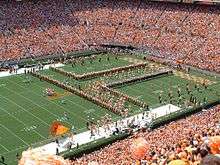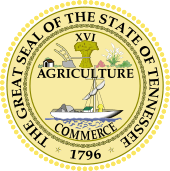Knoxville, Tennessee
Knoxville is a city in, and the county seat of Knox County in the U.S. state of Tennessee.[15] As of July 1, 2019, Knoxville's population was 187,603,[16] making it the largest city in the East Tennessee Grand Division, and the state’s overall third largest city after Nashville and Memphis.[17] Knoxville is the principal city of the Knoxville Metropolitan Statistical Area, which was 868,546 in 2015.[18]
Knoxville, Tennessee | |
|---|---|
| City of Knoxville | |
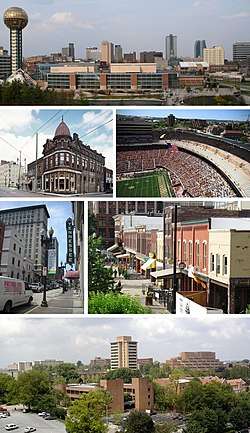 Clockwise from top: Skyline of Knoxville, Neyland Stadium, Market Square, University of Tennessee campus, Gay Street in Downtown, and Patrick Sullivan's Saloon in Old City | |
 Seal Logo | |
| Nickname(s): | |
 Location of Knoxville in Knox County, Tennessee. | |
 Knoxville, Tennessee Location in the United States  Knoxville, Tennessee Knoxville, Tennessee (the United States)  Knoxville, Tennessee Knoxville, Tennessee (North America) | |
| Coordinates: 35.9617°N 83.9232°W | |
| Country | |
| State | |
| County | Knox |
| Settled | 1786 |
| Founded | 1791 |
| Incorporated | 1815 |
| Founded by | James White |
| Named for | Henry Knox |
| Government | |
| • Type | Mayor–council |
| • Mayor | Indya Kincannon (D) |
| • City Council | Council Members
|
| Area | |
| • City | 104.25 sq mi (270.01 km2) |
| • Land | 98.72 sq mi (255.69 km2) |
| • Water | 5.53 sq mi (14.32 km2) 5.4% |
| Elevation | 886 ft (270 m) |
| Population | |
| • City | 178,874 |
| • Estimate (2019)[12] | 187,603 |
| • Rank | US: 129th |
| • Density | 1,900.30/sq mi (733.71/km2) |
| • Urban | 558,696 (US: 74th) |
| • Metro | 868,546 (US: 64th) |
| • CSA | 1,096,961 (US: 50th) |
| Demonym(s) | Knoxvillian |
| Time zone | UTC−5 (EST) |
| • Summer (DST) | UTC−4 (EDT) |
| Zip code | 37901-37902, 37909, 37912, 37914-37920-37924, 37927-37934, 37938-37940, 37950, 37995-37998 |
| Area code(s) | 865 |
| FIPS code[13] | 47-40000 |
| GNIS feature ID[14] | 1648562 |
| Primary Airport | McGhee Tyson Airport |
| Interstate | |
| U.S. Routes | |
| Website | www |
First settled in 1786, Knoxville was the first capital of Tennessee. The city struggled with geographic isolation throughout the early 19th century. The arrival of the railroad in 1855 led to an economic boom.[19] During the Civil War, the city was bitterly divided over the secession issue, and was occupied alternately by both Confederate and Union armies.[19] Following the war, Knoxville grew rapidly as a major wholesaling and manufacturing center. The city's economy stagnated after the 1920s as the manufacturing sector collapsed, the downtown area declined and city leaders became entrenched in highly partisan political fights.[19] Hosting the 1982 World's Fair helped reinvigorate the city,[19] and revitalization initiatives by city leaders and private developers have had major successes in spurring growth in the city, especially the downtown area.[20]
Knoxville is the home of the flagship campus of the University of Tennessee, whose sports teams, the Tennessee Volunteers, are popular in the surrounding area. Knoxville is also home to the headquarters of the Tennessee Valley Authority, the Tennessee Supreme Court's courthouse for East Tennessee, and the corporate headquarters of several national and regional companies. As one of the largest cities in the Appalachian region, Knoxville has positioned itself in recent years as a repository of Appalachian culture and is one of the gateways to the Great Smoky Mountains National Park.[21][22]
History
Early history
The first people to form substantial settlements in what is now Knoxville were indigenous people who arrived during the Woodland period (c. 1000 B.C. – A.D 1000).[23] One of the oldest artificial structures in Knoxville is a burial mound constructed during the early Mississippian culture period (c. A.D. 1000-1400). The earthwork mound has been preserved, but the campus of the University of Tennessee developed around it.[24]
Other prehistoric sites include an Early Woodland habitation area at the confluence of the Tennessee River and Knob Creek (near the Knox-Blount county line),[23] and Dallas Phase Mississippian villages at Post Oak Island (also along the river near the Knox-Blount line),[25] and at Bussell Island (at the mouth of the Little Tennessee River near Lenoir City).[26]
By the 18th century, the Cherokee, an Iroquoian language people, had become the dominant tribe in the East Tennessee region; they are believed to have migrated centuries before from the Great Lakes area. They were consistently at war with the Creek (who spoke Muskogee) and Shawnee (who spoke Central Algonquian).[27][28] The Cherokee people called the Knoxville area kuwanda'talun'yi, which means "Mulberry Place."[29] Most Cherokee habitation in the area was concentrated in what the American colonists called the Overhill settlements along the Little Tennessee River, southwest of Knoxville.
The first white traders and explorers were recorded as arriving in the Tennessee Valley in the late 17th century. There is significant evidence that Spanish explorer Hernando de Soto visited Bussell Island in 1540.[30] The first major recorded Euro-American presence in the Knoxville area was the Timberlake Expedition, which passed through the confluence of the Holston and French Broad into the Tennessee River in December 1761. Henry Timberlake, an Anglo-American emissary from the British colonies to the Overhill settlements along the Little Tennessee River, recalled being pleased by the deep waters of the Tennessee after his party had struggled down the relatively shallow Holston for several weeks.[31]
Settlement
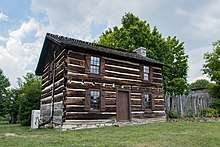
The end of the French and Indian War and confusion brought about by the American Revolution led to a drastic increase in Euro-American settlement west of the Appalachians.[32] By the 1780s, white settlers were already established in the Holston and French Broad valleys. The U.S. Congress ordered all illegal settlers out of the valley in 1785, but with little success. As settlers continued to trickle into Cherokee lands, tensions between the settlers and the Cherokee rose steadily.[33]
In 1786, James White, a Revolutionary War officer, and his friend James Connor built White's Fort near the mouth of First Creek, on land White had purchased three years earlier.[34] In 1790, White's son-in-law, Charles McClung—who had arrived from Pennsylvania the previous year—surveyed White's holdings between First Creek and Second Creek for the establishment of a town. McClung drew up 64 0.5-acre (0.20 ha) lots. The waterfront was set aside for a town common. Two lots were set aside for a church and graveyard (First Presbyterian Church, founded 1792). Four lots were set aside for a school. That school was eventually chartered as Blount College and it served as the starting point for the University of Tennessee, which uses Blount College's founding date of 1794, as its own. Also in 1790, President George Washington appointed North Carolina surveyor William Blount governor of the newly created Territory South of the River Ohio.
One of Blount's first tasks was to meet with the Cherokee and establish territorial boundaries and resolve the issue of illegal settlers.[35] This he accomplished almost immediately with the Treaty of Holston, which was negotiated and signed at White's Fort in 1791. Blount originally wanted to place the territorial capital at the confluence of the Clinch River and Tennessee River (now Kingston), but when the Cherokee refused to cede this land, Blount chose White's Fort, which McClung had surveyed the previous year. Blount named the new capital Knoxville after Revolutionary War general and Secretary of War Henry Knox, who at the time was Blount's immediate superior.[36]
Problems immediately arose from the Holston Treaty. Blount believed that he had "purchased" much of what is now East Tennessee when the treaty was signed in 1791. However, the terms of the treaty came under dispute, culminating in continued violence on both sides. When the government invited Cherokee chief Hanging Maw for negotiations in 1793, Knoxville settlers attacked the Cherokee against orders, killing the chief's wife. Peace was renegotiated in 1794.[37]
Antebellum era
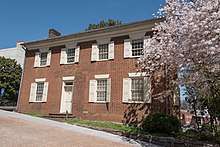
Knoxville served as capital of the Southwest Territory and as capital of Tennessee (admitted as a state in 1796) until 1817,[34] when the capital was moved to Murfreesboro. Early Knoxville has been described as an "alternately quiet and rowdy river town."[19] Early issues of the Knoxville Gazette—the first newspaper published in Tennessee—are filled with accounts of murder, theft, and hostile Cherokee attacks. Abishai Thomas, a friend of William Blount, visited Knoxville in 1794 and wrote that, while he was impressed by the town's modern frame buildings, the town had "seven taverns" and no church.[38]
Knoxville initially thrived as a way station for travelers and migrants heading west. Its location at the confluence of three major rivers in the Tennessee Valley brought flatboat and later steamboat traffic to its waterfront in the first half of the 19th century, and Knoxville quickly developed into a regional merchandising center. Local agricultural products—especially tobacco, corn, and whiskey—were traded for cotton, which was grown in the Deep South.[34] The population of Knoxville more than doubled in the 1850s with the arrival of the East Tennessee and Georgia Railroad in 1855.[19]'
Among the most prominent citizens of Knoxville during the Antebellum years was James White's son, Hugh Lawson White (1773–1840). White first served as a judge and state senator, before being nominated by the state legislature to replace Andrew Jackson in the U.S. Senate in 1825. In 1836, White ran unsuccessfully for president, representing the Whig Party.[39]
American Civil War
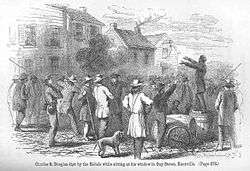
Anti-slavery and anti-secession sentiment ran high in East Tennessee in the years leading up to the American Civil War. William "Parson" Brownlow, the radical publisher of the Knoxville Whig, was one of the region's leading anti-secessionists (although he strongly defended the practice of slavery).[40] Blount County, just south of Knoxville, had developed into a center of abolitionist activity, due in part to its relatively large Quaker faction and the anti-slavery president of Maryville College, Isaac Anderson.[41] The Greater Warner Tabernacle AME Zion Church, Knoxville was reportedly a station on the underground railroad.[42]
Business interests, however, guided largely by Knoxville's trade connections with cotton-growing centers to the south, contributed to the development of a strong pro-secession movement within the city. The city's pro-secessionists included among their ranks Dr. J.G.M. Ramsey, a prominent historian whose father had built the Ramsey House in 1797.
Thus, while East Tennessee and greater Knox County voted decisively against secession in 1861, the city of Knoxville favored secession by a 2-1 margin. In late May 1861, just before the secession vote, delegates of the East Tennessee Convention met at Temperance Hall in Knoxville in hopes of keeping Tennessee in the Union. After Tennessee voted to secede in June, the convention met in Greeneville and attempted to create a separate Union-aligned state in East Tennessee.[43][44]
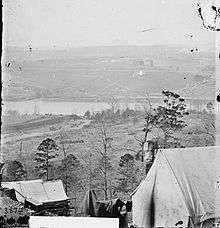
In July 1861, after Tennessee had joined the Confederacy, General Felix Zollicoffer arrived in Knoxville as commander of the District of East Tennessee. While initially lenient toward the city's Union sympathizers, Zollicoffer instituted martial law in November, after pro-Union guerrillas burned seven of the city's bridges. The command of the district passed briefly to George Crittenden and then to Kirby Smith, who launched an unsuccessful invasion of Kentucky in August 1862. In early 1863, General Simon Buckner took command of Confederate forces in Knoxville. Anticipating a Union invasion, Buckner fortified Fort Loudon (in West Knoxville, not to be confused with the colonial fort to the southwest) and began constructing earthworks throughout the city. However, the approach of stronger Union forces under Ambrose Burnside in the summer of 1863 forced Buckner to evacuate Knoxville before the earthworks were completed.[45]
| Wikimedia Commons has media related to Knoxville during the Civil War. |
Burnside arrived in early September 1863. Like the Confederates, he immediately began fortifying the city. The Union forces rebuilt Fort Loudon and erected 12 other forts and batteries flanked by entrenchments around the city. Burnside moved a pontoon bridge upstream from Loudon, allowing Union forces to cross the river and build a series of forts along the heights of South Knoxville, including Fort Stanley and Fort Dickerson.[46]
As Burnside was fortifying Knoxville, the Confederate army defeated the Union forces at the Battle of Chickamauga (near the Tennessee-Georgia line) and laid siege to Chattanooga. On November 3, 1863, the Confederates sent General James Longstreet to attack Burnside at Knoxville. Longstreet wanted to attack the city from the south, but lacking the necessary pontoon bridges, he was forced to cross the river further downstream at Loudon (November 14) and march against the city's heavily fortified western section. On November 15, General Joseph Wheeler unsuccessfully attempted to dislodge Union forces in the heights of South Knoxville, and the following day Longstreet failed to cut off retreating Union forces at Campbell's Station (now Farragut). On November 18, Union General William P. Sanders was mortally wounded while conducting delaying maneuvers west of Knoxville, and Fort Loudon was renamed Fort Sanders in his honor. On November 29, following a two-week siege, the Confederates attacked Fort Sanders, but failed after a fierce 20-minute engagement. On December 4, after word of the Confederate setback at Chattanooga reached Longstreet, he abandoned his attempts to capture Knoxville and went into winter quarters at Russellville. He rejoined the Army of Northern Virginia the following Spring.[47]
Reconstruction and the Industrial Age
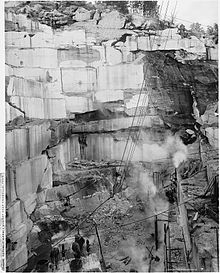
After the war, northern investors such as the brothers Joseph and David Richards helped Knoxville recover relatively quickly. Joseph and David Richards convinced 104 Welsh immigrant families to migrate from the Welsh Tract in Pennsylvania to work in a rolling mill then co-owned by Thomas Walker. These Welsh families settled in an area now known as Mechanicsville. The Richards brothers also co-founded the Knoxville Iron Works beside the L&N Railroad, also employing Welsh workers. Later, the site was used as the grounds for the 1982 World's Fair.
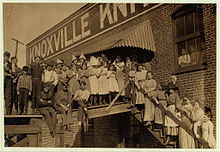
Other companies that sprang up during this period were Knoxville Woolen Mills, Dixie Cement, and Woodruff's Furniture. Between 1880 and 1887, 97 factories were established in Knoxville, most of them specializing in textiles, food products, and iron products.[48] By the 1890s, Knoxville was home to more than 50 wholesaling houses, making it the third largest wholesaling center by volume in the South.[48] The Candoro Marble Works, established in the community of Vestal in 1914, became the nation's foremost producer of pink marble and one of the nation's largest marble importers.[49] In 1896, Knoxville celebrated its achievements by creating its own flag.[50] The Flag of Knoxville, Tennessee represents the city's progressive growth due to agriculture and industry.[51]
In 1869, Thomas Humes, a Union-sympathizer and president of East Tennessee University, secured federal wartime restitution funding, and state-designated Morrill Act funding to expand the college, which had been occupied by both armies during the war.[52] In 1879, the school changed its name to the University of Tennessee, hoping to secure more funding from the Tennessee state legislature. Charles Dabney, who became president of the university in 1887, overhauled the faculty and established a law school in an attempt to modernize the scope of the university.[52]
The post-war manufacturing boom brought thousands of immigrants to the city. The population of Knoxville grew from around 5,000 in 1860 to 32,637 in 1900. West Knoxville was annexed in 1897, and over 5,000 new homes were built between 1895 and 1904.[19]
In 1901, train robber Kid Curry (whose real name was Harvey Logan), a member of Butch Cassidy's Wild Bunch was captured after shooting two deputies on Knoxville's Central Avenue. He escaped from the Knoxville Jail and rode away on a horse stolen from the sheriff.
The Progressive Era and the Great Depression
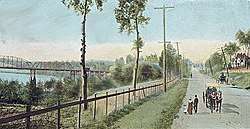
The growing city of Knoxville hosted the Appalachian Exposition in 1910 and again in 1911, and the National Conservation Exposition in 1913. The latter is sometimes credited with giving rise to the movement to create a national park in the Great Smoky Mountains, some 20 miles (32 km) south of Knoxville.[53] Around this time, a number of affluent Knoxvillians began purchasing summer cottages in Elkmont, and began to pursue the park idea more vigorously. They were led by Knoxville businessman Colonel David C. Chapman, who, as head of the Great Smoky Mountains Park Commission, was largely responsible for raising the funds for the purchase of the property that became the core of the park. The Great Smoky Mountains National Park opened in 1933.[54]
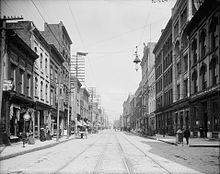
Knoxville's reliance on a manufacturing economy left it particularly vulnerable to the effects of the Great Depression. The Tennessee Valley also suffered from frequent flooding, and millions of acres of farmland had been ruined by soil erosion. To control flooding and improve the economy in the Tennessee Valley, the federal government created the Tennessee Valley Authority in 1933. Beginning with Norris Dam, TVA constructed a series of hydroelectric and other power plants throughout the valley over the next few decades, bringing flood control, jobs, and electricity to the region.[55] The Federal Works Projects Administration, which also arrived in the 1930s, helped build McGhee-Tyson Airport and expand Neyland Stadium.[19] TVA's headquarters, which consists of two twin high rises built in the 1970s, were among Knoxville's first modern high-rise buildings.
In 1948, the soft drink Mountain Dew was first marketed in Knoxville, originally designed as a mixer for whiskey.[56] Around the same time, John Gunther dubbed Knoxville the "ugliest city" in America in his best-selling book Inside U.S.A. Gunther's description jolted the city into enacting a series of beautification measures that helped improve the appearance of the Downtown area.[53]
Modern day
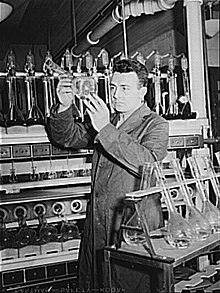
Knoxville's textile and manufacturing industries largely fell victim to foreign competition in the 1950s and 1960s, and after the establishment of the Interstate Highway system in the 1960s, the railroad—which had been largely responsible for Knoxville's industrial growth—began to decline. The rise of suburban shopping malls in the 1970s drew retail revenues away from Knoxville's Downtown area. While government jobs and economic diversification prevented widespread unemployment in Knoxville, the city sought to recover the massive loss of revenue by attempting to annex neighboring communities in Knox County. These annexation attempts often turned combative, and several attempts to merge the Knoxville and Knox County governments failed though the school boards merged on July 1, 1987.[19]

With annexation attempts stalling, Knoxville initiated several projects aimed at boosting revenue in the Downtown area. The 1982 World's Fair—the most successful of these projects—became one of the most popular world's fairs in U.S. history with 11 million visitors. The fair's energy theme was selected due to Knoxville being the headquarters of the Tennessee Valley Authority and for the city's proximity to the Oak Ridge National Laboratory. The Sunsphere, a 266-foot (81 m) steel truss structure topped with a gold-colored glass sphere, was built for the fair and remains one of Knoxville's most prominent structures,[57] along with the adjacent Tennessee Amphitheater which underwent a renovation that was completed in 2008.
Ever since, Knoxville's downtown has been developing, with the opening of the Women's Basketball Hall of Fame and the Knoxville Convention Center, redevelopment of Market Square, a new visitors center, a regional history museum, a Regal Cinemas theater, several restaurants and bars, and many new and redeveloped condominiums. Since 2000, Knoxville has successfully brought business back to the downtown area. The arts in particular have begun to flourish; there are multiple venues for outdoor concerts, and Gay Street. hosts a new arts annex and gallery surrounded by many studios and new business as well. The Tennessee and Bijou Theaters underwent renovation, providing a good basis for the city and its developers to re-purpose the old downtown.[58]
Development has also expanded across the Tennessee River on the South Knoxville waterfront. In 2006, the City of Knoxville adopted the South Waterfront Vision Plan, a long-term improvement project to revitalize the 750 acre waterfront fronting 3 miles of shoreline on the Tennessee River.[59] The project's primary focus is the commercial and residential development over a 20 year timeline.[59] The former Knoxville Baptist Hospital, located on the waterfront, was demolished in 2016 to make for mixed-use project called One Riverwalk.[60] The development consisted of three office buildings, including a new headquarters for Regal Entertainment Group, a hotel, student housing, and 300 multi-family residential units.[60]
Geography
Topography

According to the United States Census Bureau, the city has a total area of 104.2 square miles (269.8 km2), of which 98.5 square miles (255.2 km2) is land and 5.6 square miles (14.6 km2), or 5.42%, is water.[61] Elevations range from just over 800 feet (240 m) along the riverfront to just over 1,000 feet (300 m) on various hilltops in West Knoxville,[62][63] with the downtown area resting at just over 900 feet (270 m).[64] High points include Sharp's Ridge in North Knoxville at 1,391 feet (424 m) and Brown Mountain in South Knoxville at 1,260 feet (380 m).[65][66] House Mountain, the highest point in Knox County at 2,064 feet (629 m), is located east of the city near Mascot.[67][68]
Knoxville is situated in the Great Appalachian Valley (known locally as the Tennessee Valley), about halfway between the Great Smoky Mountains to the east and the Cumberland Plateau to the west. The Great Valley is part of a sub-range of the Appalachian Mountains known as the Ridge-and-Valley Appalachians, which is characterized by long, narrow ridges, flanked by broad valleys. Prominent Ridge-and-Valley structures in the Knoxville area include Sharp's Ridge and Beaver Ridge in the northern part of the city, Brown Mountain in South Knoxville, parts of Bays Mountain just south of the city, and parts of McAnnally Ridge in the northeastern part of the city.
The Tennessee River, which slices through the downtown area, is formed in southeastern Knoxville at the confluence of the Holston River, which flows southwest from Virginia, and the French Broad River, which flows west from North Carolina. The section of the Tennessee River that passes through Knoxville is part of Fort Loudoun Lake, an artificial reservoir created by TVA's Fort Loudoun Dam about 30 miles (48 km) downstream in Lenoir City. Notable tributaries of the Tennessee in Knoxville include First Creek and Second Creek, which flow through the downtown area, Third Creek, which flows west of U.T., and Sinking Creek, Ten Mile Creek, and Turkey Creek, which drain West Knoxville.
Climate
Knoxville falls in the humid subtropical climate (Köppen: Cfa). Summers are the warmest time of year, with the daily average temperature in July at 78.4 °F (25.8 °C), and an average of 36 days per year with temperatures reaching 90 °F (32 °C).[69] Winters are generally much cooler and less stable, with occasional small amounts of snow. January has a daily average temperature of 38.2 °F (3.4 °C), although in most years there is at least one day (average 5.3)[70] where the high remains at or below freezing.[lower-alpha 1] The record high for Knoxville is 105 °F (41 °C) on June 30 and July 1, 2012,[71] while the record low is −24 °F (−31 °C) on January 21, 1985.[72] Annual precipitation averages just under 48 in (1,220 mm), and normal seasonal snowfall is 6.5 in (17 cm); however, usually no snow occurs outside of January and February. The one-day record for snowfall is 17.5 in (44 cm), which occurred on February 13, 1960.[73][lower-alpha 2]
| Climate data for Knoxville (McGhee Tyson Airport), 1981−2010 normals,[lower-alpha 3] extremes 1871–present[lower-alpha 4] | |||||||||||||
|---|---|---|---|---|---|---|---|---|---|---|---|---|---|
| Month | Jan | Feb | Mar | Apr | May | Jun | Jul | Aug | Sep | Oct | Nov | Dec | Year |
| Record high °F (°C) | 77 (25) |
83 (28) |
88 (31) |
93 (34) |
96 (36) |
105 (41) |
105 (41) |
102 (39) |
103 (39) |
96 (36) |
85 (29) |
80 (27) |
105 (41) |
| Mean maximum °F (°C) | 67.2 (19.6) |
71.3 (21.8) |
79.1 (26.2) |
84.6 (29.2) |
87.9 (31.1) |
92.8 (33.8) |
95.2 (35.1) |
94.6 (34.8) |
91.1 (32.8) |
83.7 (28.7) |
76.6 (24.8) |
68.3 (20.2) |
96.1 (35.6) |
| Average high °F (°C) | 47.3 (8.5) |
52.3 (11.3) |
61.4 (16.3) |
70.3 (21.3) |
78.1 (25.6) |
85.4 (29.7) |
88.2 (31.2) |
87.8 (31.0) |
81.8 (27.7) |
71.2 (21.8) |
60.4 (15.8) |
49.8 (9.9) |
69.6 (20.9) |
| Average low °F (°C) | 29.2 (−1.6) |
32.4 (0.2) |
39.2 (4.0) |
47.3 (8.5) |
56.2 (13.4) |
64.7 (18.2) |
68.7 (20.4) |
67.8 (19.9) |
60.4 (15.8) |
48.5 (9.2) |
39.0 (3.9) |
31.7 (−0.2) |
48.8 (9.3) |
| Mean minimum °F (°C) | 9.6 (−12.4) |
14.2 (−9.9) |
22.2 (−5.4) |
30.8 (−0.7) |
40.8 (4.9) |
52.7 (11.5) |
59.9 (15.5) |
59.7 (15.4) |
46.2 (7.9) |
32.6 (0.3) |
23.6 (−4.7) |
14.8 (−9.6) |
5.6 (−14.7) |
| Record low °F (°C) | −24 (−31) |
−10 (−23) |
1 (−17) |
22 (−6) |
32 (0) |
42 (6) |
49 (9) |
49 (9) |
35 (2) |
24 (−4) |
5 (−15) |
−6 (−21) |
−24 (−31) |
| Average precipitation inches (mm) | 4.32 (110) |
4.26 (108) |
4.34 (110) |
4.01 (102) |
4.51 (115) |
3.81 (97) |
5.08 (129) |
3.27 (83) |
3.24 (82) |
2.51 (64) |
4.01 (102) |
4.50 (114) |
47.86 (1,216) |
| Average snowfall inches (cm) | 2.7 (6.9) |
1.6 (4.1) |
0.9 (2.3) |
0.5 (1.3) |
0 (0) |
0 (0) |
0 (0) |
0 (0) |
0 (0) |
0 (0) |
trace | 0.8 (2.0) |
6.5 (17) |
| Average precipitation days (≥ 0.01 in) | 11.2 | 11.0 | 12.0 | 10.7 | 11.4 | 11.4 | 11.3 | 8.8 | 7.7 | 8.2 | 9.9 | 11.6 | 125.2 |
| Average snowy days (≥ 0.1 in) | 1.5 | 1.2 | 0.6 | 0.1 | 0 | 0 | 0 | 0 | 0 | 0 | 0 | 0.8 | 4.2 |
| Average relative humidity (%) | 71.7 | 68.0 | 64.8 | 63.3 | 70.8 | 73.5 | 75.7 | 76.3 | 76.1 | 73.0 | 71.8 | 72.9 | 71.5 |
| Mean monthly sunshine hours | 135.8 | 145.3 | 208.9 | 256.6 | 287.2 | 291.1 | 287.3 | 278.0 | 232.3 | 217.2 | 151.7 | 122.5 | 2,613.9 |
| Percent possible sunshine | 44 | 48 | 56 | 65 | 66 | 67 | 65 | 67 | 62 | 62 | 49 | 40 | 59 |
| Source: NOAA (relative humidity and sun 1961–1990)[70][74][75] | |||||||||||||
Metropolitan Area
Knoxville is the central city in the Knoxville Metropolitan Area, an Office of Management and Budget (OMB)-designated metropolitan statistical area (MSA) that covers Knox, Anderson, Blount, Campbell, Grainger, Loudon, Morgan, Roane and Union counties. MSAs consist of a core urban center and the outlying communities and rural areas with which it maintains close economic ties. They are not administrative divisions, and should not be confused with a consolidated city-county government, which Knoxville and Knox County is absent of.[76]
The Knoxville Metropolitan area includes unincorporated communities such as Halls Crossroads, Powell, Karns, Corryton, Concord, and Mascot, which are located in Knox County outside of Knoxville's city limits. Along with Knoxville, major municipalities in the Knoxville Metropolitan Area include Alcoa, Blaine, Maryville, Lenoir City, Loudon, Farragut, Oak Ridge, Rutledge, Clinton, Bean Station, and Maynardville. As of 2012, the population of the Knoxville Metropolitan Area was 837,571.[76]
Additionally, the Knoxville MSA is the chief component of the larger OMB-designated Knoxville-Sevierville-La Follette TN Combined Statistical Area (CSA). The CSA also includes the Morristown Metropolitan Statistical Area (Hamblen, Grainger, and Jefferson counties) and the Sevierville (Sevier County), La Follette (Campbell County), Harriman (Roane County), and Newport (Cocke County) Micropolitan Statistical Areas. Municipalities in the CSA, but not the Knoxville MSA, include Morristown, Rutledge, Dandridge, Jefferson City, Sevierville, Gatlinburg, Pigeon Forge, LaFollette, Jacksboro, Harriman, Kingston, Rockwood, and Newport. The combined population of the CSA as of the 2000 Census was 935,659. Its estimated 2008 population was 1,041,955.[76]
Georgia Tech researchers have mapped the Knoxville Metropolitan area as one of the 18 'Major Cities' in the Piedmont Atlantic Megaregion.[77]
Cityscape

Architecture
Knoxville's two tallest buildings are the 27-story First Tennessee Plaza and the 24-story Riverview Tower, both on Gay Street.[78] Other prominent high-rises include the Tower at Morgan Hill (21 stories),[79] the Andrew Johnson Building (18),[80] the Knoxville Hilton (18), the General Building (15), the Holston (14), the TVA Towers (12),[81] and Sterchi Lofts (12). The city's most iconic structure is arguably the Sunsphere, a 266-foot (81 m) steel truss tower built for the 1982 World's Fair[82] and, with the Tennessee Amphitheater, one of only two structures that remain from that World's Fair.[83]
The downtown area contains a mixture of architectural styles from various periods, ranging from the hewn-log James White House (1786) to the modern Knoxville Museum of Art (1990). Styles represented include Greek Revival (Old City Hall), Victorian (Hotel St. Oliver and Sullivan's Saloon), Gothic (Church Street Methodist Church and Ayres Hall), Neoclassical (First Baptist Church), and Art Deco (Knoxville Post Office). Gay Street, Market Square, and Jackson Avenue contain numerous examples of late-19th and early-20th century commercial architecture.
Residential architecture tends to reflect the city's development over two centuries. Blount Mansion (1791), in the oldest part of the city, is designed in a vernacular Georgian style. "Streetcar suburbs" such as Fourth and Gill, Parkridge, and Fort Sanders, developed in the late 19th century with the advent of trolleys, tend to contain large concentrations of Victorian and Bungalow/Craftsman-style houses popular during this period. Early automobile suburbs, such as Lindbergh Forest and Sequoyah Hills, contain late-1920s and 1930s styles such as Tudor Revival, English Cottage, and Mission Revival. Neighborhoods developed after World War II typically consist of Ranch-style houses.
Knoxville is home to the nation's largest concentration of homes designed by noted Victorian residential architect George Franklin Barber, who lived in the city.[84] Other notable local architects include members of the Baumann family, Charles I. Barber (son of George), R. F. Graf, and more recently, Bruce McCarty. Nationally renowned architects with works still standing in the city include Alfred B. Mullett (Greystone), John Russell Pope (H.L. Dulin House), and Edward Larrabee Barnes (Knoxville Museum of Art).
Neighborhoods
Knoxville is roughly divided into the Downtown area and sections based on the four cardinal directions: North Knoxville, South Knoxville, East Knoxville, and West Knoxville. Downtown Knoxville traditionally consists of the area bounded by the river on the south, First Creek on the east, Second Creek on the west, and the railroad tracks on the north, though the definition has expanded to include the U.T. campus and Fort Sanders neighborhood,[85] and several neighborhoods along or just off Broadway south of Sharp's Ridge ("Downtown North").[86] While primarily home to the city's central business district and municipal offices, the Old City and Gay Street are mixed residential and commercial areas.
South Knoxville consists of the parts of the city located south of the river,[85] and includes the neighborhoods of Vestal, Lindbergh Forest, Island Home Park, Colonial Hills, and Old Sevier. This area contains major commercial corridors along Chapman Highway and Alcoa Highway.
West Knoxville generally consists of the areas west of U.T.,[85] and includes the neighborhoods of Sequoyah Hills, West Hills, Bearden, Cumberland Estates, Westmoreland, Suburban Hills, Cedar Bluff, Rocky Hill, and Ebenezer. This area, concentrated largely around Kingston Pike, is home to thriving retail centers such as West Town Mall.
East Knoxville consists of the areas east of First Creek and the James White Parkway,[85] and includes the neighborhoods of Parkridge, Burlington, Morningside, and Five Points. This area, concentrated along Magnolia Avenue, is home to Chilhowee Park and Zoo Knoxville.
North Knoxville consists of the areas north of Sharp's Ridge,[85] namely the Fountain City and Inskip-Norwood areas. This area's major commercial corridor is located along Broadway.
List of notable neighborhoods
- Bearden
- Chilhowee Park
- Colonial Village
- Cumberland Estates
- Downtown
- Emory Place
- Fort Sanders
- Fountain City
- Oakland (former)
- Fourth & Gill
- Island Home Park
- Lindbergh Forest
- Lonsdale
- Mechanicsville
- North Hills
- Oakwood-Lincoln Park
- Old City
- Old North Knoxville
- Parkridge
- Rocky Hill
- Sequoyah Hills
- South Knoxville
- West Hills
Demographics
| Historical population | |||
|---|---|---|---|
| Census | Pop. | %± | |
| 1850 | 2,076 | — | |
| 1870 | 8,682 | — | |
| 1880 | 9,693 | 11.6% | |
| 1890 | 22,535 | 132.5% | |
| 1900 | 32,637 | 44.8% | |
| 1910 | 36,346 | 11.4% | |
| 1920 | 77,818 | 114.1% | |
| 1930 | 105,802 | 36.0% | |
| 1940 | 111,580 | 5.5% | |
| 1950 | 124,769 | 11.8% | |
| 1960 | 111,827 | −10.4% | |
| 1970 | 174,587 | 56.1% | |
| 1980 | 175,045 | 0.3% | |
| 1990 | 165,121 | −5.7% | |
| 2000 | 173,890 | 5.3% | |
| 2010 | 178,874 | 2.9% | |
| Est. 2019 | 187,603 | [12] | 4.9% |
| Sources:[87] | |||
| Racial composition | 1970[88] | 1990[88] | 2000[89] | 2010[89] | 2018 est.[90] |
|---|---|---|---|---|---|
| White | 87.0% | 82.7% | 79.9% | 76.1% | 75.3% |
| Black | 12.7% | 15.8% | 16.0% | 17.1% | 17.5% |
| Asian | 0.2% | 1.0% | 1.5% | 1.7% | 1.8% |
| Native | 0.1% | 0.2% | 0.3% | 0.4% | 0.5% |
| Native Hawaiian and other Pacific Islander | - | - | 0.0% | 0.2% | 0.1% |
| Other race | 0.1% | 0.2% | 0.7% | 2.2% | 1.8% |
| Two or more races | - | – | 1.6% | 2.5% | 3.0% |
As of the census of 2010, the population of Knoxville was 178,874, a 2.9% increase from 2000.[91] The median age was 32.7,[92] with 19.1% of the population under the age of 18, and 12.6% over the age of 65.[91] The population was 48% male and 52% female. The population density was 1,815 persons per square mile.[91]
The racial and ethnic composition of the city was 76.1% white, 17.1% black, 0.4% Native American, 1.6% Asian, and 0.2% Pacific Islander.[91] Hispanic or Latino of any race were 4.6% of the population.[91] People reporting more than one race formed 2.5% of the population.[91]
Data collected by the Census from 2005 to 2009 reported 83,151 households in Knoxville, with an average of 2.07 persons per household.[91] The home ownership rate was 51%, and 74.7% of residents had been living in the same house for more than one year.[91] The median household income was $32,609, and the per capita income was $21,528.[91] High school graduates were 83.8% of persons 25 and older, and 28.3% had earned a bachelor's degree or higher.[91] The city's poverty rate was 25%, compared with 16.1% in Tennessee and 15.1% nationwide.[91][93]
According to the opinion of the Economic Research Institute in a 2006 study, Knoxville was identified as the most affordable U.S. city for new college graduates, based on the ratio of typical salary to cost of living.[94] In 2014, Forbes ranked Knoxville one of the top five most affordable cities in the United States.[95]
Crime
FBI Uniform Crime Reports for Knoxville for 2017:[96]
| City of Knoxville only | Knoxville MSA | Rate per 100,000 Inhabitants | |
|---|---|---|---|
| Violent Crime | 1,676 | 3,852 | 440.1 |
| Murder & Nonnegligent Manslaughter | 33 | 60 | 6.9 |
| Rape | 145 | 311 | 35.5 |
| Robbery | 371 | 528 | 60.3 |
| Aggravated Assault | 1,127 | 2,953 | 337.4 |
| Property Crime | 10,211 | 22,730 | 2,596.9 |
| Burglary | 1,665 | 4,387 | 501.2 |
| Larceny/Theft | 7,510 | 15,953 | 1,822.6 |
| Motor Vehicle Theft | 1,036 | 2,390 | 273.1 |
Economy
After the arrival of the railroads in the 1850s, Knoxville grew to become a major wholesaling and manufacturing center. Following the collapse of the city's textile industry in the 1950s, Knoxville's economy grew more diversified. In 2011, 15.9% of the Knoxville Metropolitan Statistical Area's (MSA) work force was employed by government entities, while 14.1% were employed in the professional service sector, 14% worked in education or health care, 12.7% were employed in the retail sector, 10.5% worked in leisure and hospitality, and 8.9% worked in the manufacturing sector.[97] The region had an unemployment rate of 7.9% in 2011.[97]
In the 2010 ACCRA Cost of Living Index, Knoxville was rated 89.6 (the national average was 100).[97] Kiplinger ranked Knoxville at #5 in its list of Best Value Cities 2011 citing "college sports, the Smoky Mountains and an entrepreneurial spirit."[98] In April 2008, Forbes magazine named Knoxville among the Top 10 Metropolitan Hotspots in the United States,[99] and within Forbes' Top 5 for Business & Careers, just behind cities like New York and Los Angeles.[100]
In 2007, there were over 19,000 registered businesses in Knoxville.[91] The city's businesses are served by the 2,100-member Knoxville Area Chamber Partnership.[97] The Knoxville Chamber is one of six partners in the Knoxville-Oak Ridge Innovation Valley, which promotes economic development in Knox and surrounding counties.[101]
Major corporations
The Tennessee Valley Authority (TVA), the nation's largest public power provider,[102] is a federally owned corporation headquartered in Knoxville. TVA reported $11.8 billion in revenue in 2011,[103] and employs over 12,000 region-wide.[104]
The largest company based in Knoxville is movie theater chain Regal Cinemas.[105][106] The second largest company with operations in Knoxville is Discovery, Inc. (formerly the headquarters of Scripps Networks Interactive) ($2.07 billion), followed by the health care-staffing firm TeamHealth ($1.52 billion).[105]
The largest privately held company based in Knoxville is Pilot Flying J, the nation's largest truck stop chain and sixth largest private company, which reported over $29.23 billion in revenue in 2012.[107] Knoxville is also home to the nation's fourth largest wholesale grocer, The H. T. Hackney Company, which reported $3.8 billion in revenue in 2012,[108] and one of the nation's largest digital-centric advertising firms, Tombras Group, which reported $80 million in revenue in 2011.[109][110] Other notable privately held companies based in the city include Bush Brothers, Sea Ray (and its parent company, Brunswick Boat Group), Thermocopy, Petro's Chili & Chips, EdFinancial, 21st Mortgage and AC Entertainment.
Major companies located within the Knoxville MSA include Clayton Homes and Ruby Tuesday (both in Maryville), and DeRoyal and Weigel's (both in Powell).
Real estate
As of 2011, the median price for a home in the Knoxville MSA was $140,900, compared with $173,300 nationally.[97] The average apartment rental was $658 per month.[97] In March 2009, CNN ranked Knoxville as the 59th city in the top 100 US metro areas in terms of real estate price depreciation.[111]
The Knoxville area is home to 596 office buildings which contain over 21 million square feet of office space.[97] As of 2010, the average rental rate per square foot was $14.79.[97] The city's largest office building in terms of office space is the City-County Building, which has over 537,000 square feet of office space. The First Tennessee Plaza and the Riverview Tower were the largest privately owned office buildings, with 469,672 square feet and 367,000 square feet, respectively.[112]
Knoxville's largest industrial park is the 1,460-acre (590 ha) Forks of the River Industrial Park in southeastern Knoxville.[113] Other major industrial and business parks include the 800-acre (320 ha) EastBridge Industrial Park and Midway Business Park in eastern Knox County and the 271-acre (110 ha) WestBridge Industrial Park in western Knox County.
Finance
The largest bank operating in Knoxville in terms of local deposits is Memphis-based First Tennessee, with $2.6 billion in local deposits, representing about 16% of Knoxville's banking market.[114] It is followed by Charlotte-based Truist Financial ($2.5 billion), Birmingham-based Regions Bank ($1.9 billion), and locally headquartered Home Federal Bank of Tennessee ($1.6 billion).[114] Other banks with significant operations in the city include Bank of America, First Bank (based in Lexington, Tennessee), and locally owned Clayton Bank and Trust.
Major brokerage firms with offices in Knoxville include Edward Jones, Morgan Stanley Smith Barney, Wells Fargo, and Merrill Lynch.[115] As of 2011, Knox County's largest mortgage lender (by dollar volume) was Wells Fargo with over $300 million (13% of the local market), followed by Mortgage Investors Group, SunTrust, Regions, and Home Federal.[116] Knoxville's largest accounting firm as of 2012 is Pershing Yoakley & Associates, with 49 local CPAs, followed by Coulter & Justus (44), and Pugh CPA's(43).[117]
Manufacturing
Over 700 manufacturing establishments are scattered throughout the Knoxville area.[97] Sea Ray Boats is the city's largest manufacturer, employing 760 at its southeast Knoxville complex in 2009.[118] The city is home to several automobile parts operations, including ARC Automotive (air bag actuators) and a Key Safety Systems plant (seat belts and other restraints).[118] Other major manufacturing operations include a Melaleaca plant (personal care products), a Coca-Cola bottling plant, and a Gerdau Ameristeel plant that produces steel rebar. Major manufacturing operations in the Knoxville MSA are conducted at the Y-12 plant in Oak Ridge, the DENSO plant and the Clayton Homes manufacturing center (both in Maryville), and the ALCOA plants in Alcoa.[119]
Retail
The Knoxville area is home to 182 shopping centers and factory outlets, and over 2,400 retail establishments.[97] One regional mall (West Town Mall is located within the city, and two others (Foothills Mall in Maryville and Oak Ridge City Center in Oak Ridge) are located within the Knoxville MSA. Knoxville retailers reported $6.47 billion in sales in 2007, with just over $35,000 of retail sales per capita.[91]
Knoxville's primary retail corridor is located along Kingston Pike in West Knoxville. This area is home to West Town Mall, the 358-acre Turkey Creek complex (half is in Knoxville and half is Farragut), and over 30 shopping centers.[120] Downtown Knoxville contains a number of specialty shops, clubs, and dining areas, mostly concentrated in the Old City, Market Square, and along Gay Street. Other significant retail areas are located along Cumberland Avenue on the U.T. campus (mostly restaurants), Broadway in the vicinity of Fountain City, and Chapman Highway in South Knoxville.
Technology and research
The University of Tennessee is classified by the Carnegie Commission as a university with "very high research activity," conducting more than $300 million in externally funded research annually.[121] U.T.-connected research centers with multimillion-dollar National Science Foundation grants include the Appalachian Collaborative Center for Learning, Assessment and Instruction in Mathematics, the National Institute for Computational Sciences, the National Institute for Mathematical and Biological Synthesis, and the Center for Ultra-wide-area Resilient Electric Energy Transmission Networks (CURENT).[122][123] U.T. and the nearby Oak Ridge National Laboratory jointly conduct numerous research projects and co-manage the National Transportation Research Center.[121]
The Tennessee Technology Corridor stretches across 7,000 acres (2,800 ha) between West Knoxville and Oak Ridge. The Corridor is home to 13 research and development firms employing nearly 2,000.[124]
Culture
Knoxville is home to a rich arts community and has many festivals throughout the year. Its contributions to old-time, bluegrass and country music are numerous, from Flatt & Scruggs and Homer & Jethro to the Everly Brothers.
The Knoxville Symphony Orchestra (KSO), established in 1935, is the oldest continuing orchestra in the southeast.[125] The KSO maintains a core of full-time professional musicians, and performs at more than 200 events per year. Its traditional venues include the Tennessee Theatre, the Bijou Theatre, and the Civic Auditorium, though it also performs at a number of non-traditional venues.
Knoxville also boasts the Knoxville Opera which has been guided by Don Townsend for over two decades. The KOC performs a season of opera every year with a talented chorus as the backbone of each production.[126] The city is also known as a venue for Sergei Rachmaninoff's final concert in 1943.[127]
In its May 2003 "20 Most Rock & Roll towns in the U.S." feature, Blender ranked Knoxville the 17th best music scene in the United States. In the 1990s, noted alternative-music critic Ann Powers, author of Weird Like Us: My Bohemian America, referred to the city as "Austin without the hype".[128][129]
The city also hosts numerous art festivals, including the 17-day Dogwood Arts Festival in April, which features art shows, crafts fairs, food and live music. Also in April is the Rossini Festival, which celebrates opera and Italian culture. June's Kuumba (meaning creativity in Swahili) Festival commemorates the region's African American heritage and showcases visual arts, folk arts, dance, games, music, storytelling, theater, and food. Autumn on the Square showcases national and local artists in outdoor concert series at historic Market Square, which has been revitalized with specialty shops and residences.
Events
The Knoxville Christmas in the City event runs for eight weeks of events at locations throughout the city including the Singing Christmas Tree and ice skating on the Holidays on Ice skating rink.[130][131]
- Asian Festival
- Bacon Fest
- Big Ears Festival
- Big KnoxVenture Race
- Boo At The Zoo
- Boomsday
- Brewfest
- Chocolatefest Knoxville
- Concerts on the Square
- Corvette Expo
- Destination ImagiNation Global Finals
- Dogwood Arts Festival
- EarthFest
- East Tennessee Chili Cookoff
- East Tennessee History Fair
- Fantasy of Trees
- Feast With the Beasts at Knoxville Zoo
- Festival on the Fourth
- First Friday ArtWalk
- The Great Llama Race
- GreekFest
- HoLa Festival
- Honda Hoot
- IndiaFest
- International Food Festival
- International Biscuit Festival
- Knoxville Brewers' Jam
- Knoxville Lindy Exchange
- Knoxville Marathon
- Knoxville Powerboat Classic
- Kuumba Festival
- Market Square Farmers' Market
- NSRA Street Rod Nationals South
- Pride Fest
- Rhythm & Blooms Festival
- Rossini Festival
- Scruffy City Comedy Festival
- Sevier Heights Living Christmas Tree
- Shakespeare on the Square
- Tennessee Valley Fair
- Vestival
- Volapalooza
- Xterra Knoxville Triathlon
Sites of interest
- Beck Cultural Exchange Center
- Bijou Theatre
- Bleak House
- William Blount Mansion
- Fountain City Art Center
- Candoro Marble Works
- Civic Coliseum
- Fort Dickerson
- Haley Heritage Square
- Ijams Nature Center
- James White's Fort
- Knoxville Botanical Gardens and Arboretum
- Knoxville Convention Center
- Knoxville Greenways
- Knoxville Museum of Art
- Knoxville Police Museum
- Zoo Knoxville
- Mabry-Hazen House
- Marble Springs
- Market Square
- Frank H. McClung Museum
- Museum of East Tennessee History
- National Register of Historic Places, Knox County, Tennessee
- Old City
- Ramsey House
- Sunsphere
- Tennessee Amphitheater
- Tennessee River Boat
- Tennessee Theatre
- Three Rivers Rambler Train Ride
- Volunteer Landing
- Women's Basketball Hall of Fame
- World's Fair Park
Media
The Knoxville News Sentinel is the local daily newspaper in Knoxville, with a daily circulation of 97,844 and a Sunday circulation of 124,225, as of 2011.[97] The city is home to several weekly, bi-weekly, and monthly publications.
As of 2011, the Knoxville television market was the 61st-largest in the U.S. with 527,790 homes, according to Nielsen Market Research.[132] The largest local television station is NBC affiliate WBIR, with 28,305 viewing households, followed by ABC affiliate WATE (23,559), CBS affiliate WVLT (20,052), Fox affiliate WTNZ (10,319), and CW affiliate WBXX (5,415).[133] Other local stations include WKNX-TV (Ind.), WVLR (CTN) and WPXK (Ion). East Tennessee PBS operates Knoxville's Public Broadcasting Service station at WKOP 17.
Discovery, Inc. operates the former Scripps Networks Interactive cable television networks from Knoxville, including HGTV, DIY Network, Food Network, Cooking Channel, Travel Channel and Great American Country.[134] Jewelry Television, a home shopping channel, is also based in the city, and several companies that provide production services to the ex-SNI networks also maintain Knoxville operations.
According to Arbitron's 2011 Radio Market Rankings, Knoxville had the nation's 72nd largest radio market, with 684,700 households.[135] In 2010, Country music station WIVK (107.7 FM) had the market's highest AQH Share at 16.3, followed by adult contemporary station WJXB (97.5 FM) at 10.1, and news/talk station WCYQ (100.3 FM) at 8.3.[136] Other stations include Rock music stations WIMZ (103.5 FM) and WNFZ (94.3), Rhythmic Top 40 station WKHT (104.5 FM), contemporary hit station WWST (102.1 FM), and National Public Radio station WUOT (91.9 FM). The University of Tennessee radio station operates under WUTK (90.3 FM).
Sports
The University of Tennessee's athletics programs, nicknamed the "Volunteers," or the "Vols," are immensely popular in Knoxville and the surrounding region. Neyland Stadium, where the Vols' football team plays, is one of the largest stadiums in the world, and Thompson–Boling Arena, home of the men's and women's basketball teams, is one of the nation's largest indoor basketball arenas. The telephone area code for Knox County and eight adjacent counties is 865 (VOL). Knoxville is also the home of the Women's Basketball Hall of Fame, almost entirely thanks to the success of Pat Summitt and the University of Tennessee women's basketball team.
Professional sports teams located in Knoxville include
- Knoxville Force (National Premier Soccer League, Southeast Division)
- Knoxville Ice Bears (Southern Professional Hockey League)
- Tennessee Smokies (Southern League, Double-A affiliate of the Chicago Cubs)
Government
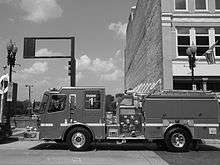
Knoxville is governed by a mayor and nine-member City Council. It uses the strong-mayor form of the mayor-council system.[137] The council consists of six members elected from single-member districts and three members elected at-large for the entire city. The council chooses from among its members the vice mayor (currently Gwen McKenzie), the Beer Board chairperson (currently Andrew Roberto), and a representative to the Knoxville Transportation Authority (currently Daniel Brown).[138] The City Council meets every other Tuesday at 7 p.m. in the Main Assembly Room of the City County Building.[139]
The current mayor is Indya Kincannon, who was sworn in as the city's second female mayor on December 21, 2019, replacing the first female mayor of the city, Madeline Rogero, who was elected in 2011. Interim mayor Daniel Brown, the first African-American to hold the office, was appointed in January 2011 following the resignation of Bill Haslam, who was elected Governor of Tennessee. Other recent mayors include Haslam's predecessor, Victor Ashe (1987−2003), Kyle Testerman (1972−1975, 1984−1987), and Randy Tyree (1976−1983).

The Knoxville Fire Department (KFD) provides Class 2 ISO service inside the city limits. The fire department operates 19 stations with 308 uniformed personnel.[140] KFD provides firefighting, first responder EMS response, vehicle extrication and HazMat response within the city limits.
The Knoxville Police Department serves the citizens of Knoxville with 378 officers and a total of 530 employees.[141]
911 ambulance service inside Knoxville is provided by AMR Ambulance under contract with Knox County.[142]
Knoxville is home to the Tennessee Supreme Court's courthouse for East Tennessee.
List of mayors
Not to be confused with the Mayor of Knox County
- Thomas Emmerson, 1816-1817[143]
- James Park, 1818-1821
- William C. Mynatt, 1822-1823, 1827, 1835-1836
- James Park, 1824-1826
- Joseph Churchill Strong, 1828-1831
- Donald McIntosh, 1832-1833
- Solomon D. Jacobs, 1834-1835
- Frederick Steidinger Heiskell, 1835
- James King, 1837
- William Baine Alexander Ramsey, 1838-1839
- Samuel Bell, 1840-1841, 1844-1845
- Gideon Morgan Hazen, 1842
- Matthew Moore Gaines, 1843
- Joseph Lewis King, 1846
- Samuel B. Boyd, 1847-1851
- George McNutt White, 1852-1853
- James C. Luttrell, 1854, 1859-1867
- William Graham Swan, 1855-1856
- James Harvey Cowan, 1856, 1858
- Thomas J. Powell, 1857
- Samuel Davies Carrick White, 1857
- Albert Morgan Piper, 1858
- Charles James McClung, 1858
- Joseph Jaques, 1858, 1878
- James M. White, 1858
- Marcus DeLafayette Bearden, 1868-1869
- John Somers Van Gilder, 1870-1872
- William Rule, 1873, 1898-1899
- Peter Staub, 1874-1875, 1881-1882
- Daniel A. Carpenter, 1876-1877
- Samuel Bell Luttrell, 1879
- Hardy Bryan Branner, 1880
- Reuben S. Payne, 1882
- William Clark Fulcher, 1883-1884
- James Churchwell Luttrell, III, 1885-1887
- Martin Condon, 1888-1889
- Peter Kern, 1890-1891
- M. E. Thompson, 1892-1895
- Samuel Gordon Heiskell, 1896-1897, 1900-1901, 1906–1907, 1910-1915
- Joseph Tedford McTeer, 1902-1903
- John Paul Murphy, 1904
- William H. Gass, 1904-1905
- John McMillan Brooks, 1908-1909
- Sam E. Hill, 1912
- John Edgar McMillan, 1916-1919
- Ernest Wesley Neal, 1920-1923
- Benjamin A. Morton, 1924-1927
- James Alexander Fowler, 1928-1929
- James A. Trent, 1930-1931
- John T. O'Connor, 1932-1935
- James W. Elmore, 1936-1937
- Walter W. Mynatt, 1938-1939
- Frederick Leland "Fred" Allen, 1940-1941
- Fred R. Stair, 1942-1943
- Erastus Eugene Patton, 1944-1945
- Cas Walker, 1946, 1959
- Edward L. Chavannes, 1946-1947
- James W. Elmore, Jr., 1948-1951
- George Roby Dempster, 1952-1955
- Jack W. Dance, 1956-1959
- John J. Duncan, 1959-1964
- Robert L. Crossley, 1964
- Leonard Reid Rogers, 1965-1971
- Kyle Testerman, 1972-1975, 1984-1987
- Randy Tyree, 1976-1983
- Victor Ashe, 1988-2003
- Bill Haslam, 2003-2011
- Daniel Brown, 2011
- Madeline Rogero, 2011–2019
- Indya Kincannon, 2019-
Education

Knoxville is home to the main campus of the University of Tennessee (UTK), which has operated in the city since the 1790s. As of 2011, UTK had an enrollment of over 27,000 and endowments of over $300 million.[144] The school employs over 1,300 instructional faculty, and offers more than 300 degree programs.[145]
Pellissippi State Community College is a two-year school governed by the Tennessee Board of Regents that offers transfer programs, two-year degrees, and certificate programs. Its main campus is located off Pellissippi Parkway in western Knox County. As of 2011, the school had a system-wide enrollment of over 11,000 students,[146]
Johnson University (formerly Johnson Bible College) is a Bible college affiliated with the Christian churches and churches of Christ. As of 2012, the school had an enrollment of 845. Johnson traditionally specializes in training preachers and ministers, but also offers degrees in counseling, teaching, music, and nonprofit management.[147]
South College (formerly Knoxville Business College) is a for-profit school located in West Knoxville that offers undergraduate and graduate programs in business, health care, criminal justice, and legal fields. The school had an enrollment of 717 as of 2010.[148]
Knoxville College was a historically black college that began operating in Knoxville in the 1870s. The school offered a Bachelor of Science in Liberal Studies and an Associate of Arts degree. Knoxville College had an enrollment of about 100 students as of 2010 and closed permanently in 2015.[149]
Institutions with branch campuses in Knoxville include King University, Lincoln Memorial University (namely, the Duncan School of Law), National College of Business & Technology, Roane State Community College, Strayer University, Tennessee Wesleyan University, and Tusculum College. Virginia College offers career programs in Knoxville.[150] Huntington College of Health Sciences, which offers distance courses in nutrition and health, has its offices in Knoxville.
Primary and secondary education
Public schools in Knoxville are part of the Knox County Schools system, which oversees 89 schools (50 elementary, 14 middle, 14 high, and 11 adult centers) serving over 56,000 students. This system includes 5 magnet schools and a STEM academy.[97] Knox County high schools had a graduation rate of 86.6%, as of 2011.[151] The average classroom ratio is 14 students per teacher.[97]
Knox County is home to over 50 private and parochial schools,[97] the largest of which include the Christian Academy of Knoxville, the Webb School of Knoxville, Knoxville Catholic High School, Grace Christian Academy, Cedar Springs Weekday School, and Sacred Heart Cathedral School.[152]
Libraries
The Knox County Public Library system consists of the Lawson McGhee Library, located downtown, and 17 branch libraries, overseeing a collection of over 1.3 million volumes.[97]
Infrastructure
Health
Knox County's hospital system contains over 2,600 licensed beds in 7 general use hospitals and one children's hospital.[97] The city's largest hospital as of 2011 was the University of Tennessee Medical Center, which had 581 beds, followed by Fort Sanders Regional Medical Center (541), Parkwest Medical Center (462), and Physicians Regional (370).[153] The city's largest ambulatory surgery center was the Parkwest Surgery Center, which employed 58 physicians and 35 nurses, followed by the Fort Sanders West Outpatient Surgery Center and the St. Mary's Ambulatory Surgery Center South.[154]
A 2009 study by the University of Wisconsin Population Health Institute found that Knox Countians had a life expectancy of 76 years.[155] The study also found that 22% of Knox County adults smoked, 28% were obese, 11% were binge drinkers, and 14% lacked health insurance.[155] In 2009, Knox County experienced 8 days of unhealthy air due to high levels of particulate matter, and 25 days due to high ozone levels.[155]
In the 2010s, Knoxville's air quality continued to greatly improve over that of past decades according to the American Lung Association's State of the Air 2017.[156]
Utilities
The Knoxville Utilities Board (KUB) provides electricity, water, and wastewater management to Knoxville residents and businesses. KUB's service area covers 688 square miles and includes over 5,200 miles of power lines providing electricity to over 196,000 customers.[157] The average electric bill was just over $96 per month.[158] KUB purchases its electricity from the Tennessee Valley Authority.[157]
Transportation
Highways

The two principal interstate highways serving Knoxville are Interstate 40, which connects the city to Asheville (directly) and Bristol (via I-81) to the east and Nashville to the west, and Interstate 75, which connects the city to Chattanooga to the south and Lexington to the north. The two interstates merge just west of Knoxville near Dixie Lee Junction and diverge as they approach the Downtown area, with I-40 continuing on through the Downtown area and I-75 turning north. Interstate 640 provides a bypass for I-40 travellers, and Interstate 275 provides a faster connection to I-75 for Downtown travellers headed north. A spur route of I-40, Interstate 140 (Pellissippi Parkway), connects West Knoxville with McGhee Tyson Airport.
Knoxville's busiest road is a stretch of U.S. Route 129 known as Alcoa Highway, which connects the Downtown area with McGhee Tyson Airport.[159] A merged stretch of US-70 and US-11 enters the city from the east along Magnolia Avenue, winds its way through the Downtown area, crosses the U.T. campus along Cumberland Avenue ("The Strip"), and proceeds through West Knoxville along Kingston Pike. US-441, which connects Knoxville to the Great Smoky Mountains National Park, passes along Broadway in North Knoxville, Henley Street in the Downtown area, and Chapman Highway in South Knoxville. US-25W connects Knoxville with Clinton.
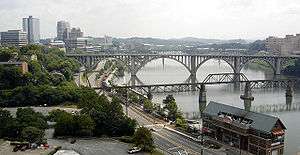
Tennessee State Route 158 loops around the Downtown area from Kingston Pike just west of U.T.'s campus, southward and eastward along Neyland Drive and the riverfront, and northward along the James White Parkway before terminating at I-40. TN-168, known as Governor John Sevier Highway, runs along the eastern and southern periphery of the city. TN-162 (Pellissippi Parkway) connects West Knoxville with Oak Ridge. TN-331 (Tazewell Pike) connects the Fountain City area to rural northeast Knox County. TN-332 (Northshore Drive) connects West Knoxville and Concord. TN-33 (Maryville Pike) traverses much of South Knoxville.
Four vehicle bridges connect Downtown Knoxville with South Knoxville, namely the South Knoxville Bridge (James White Parkway), the Gay Street Bridge (Gay Street), the Henley Street Bridge, or Henley Bridge (Henley Street), and the J. E. "Buck" Karnes Bridge (Alcoa Highway). Two railroad bridges, located between the Henley Street Bridge and Buck Karnes Bridge, serve the CSX and Northfolk Southern railroads. Smaller bridges radiating out from the downtown area include the Western Avenue Viaduct and Clinch Avenue Viaduct, the Robert Booker Bridge (Summit Hill Drive), the Hill Avenue Viaduct, and the Gay Street Viaduct.
Mass transit
Public transportation is provided by Knoxville Area Transit (KAT), which operates over 80 buses, road trolleys, and paratransit vehicles, and transports more than 3.6 million passengers per year. Regular routes connect the Downtown area, U.T., and most residential areas with major shopping centers throughout the city. KAT operates using city, state, and federal funds, and passenger fares, and is managed by Veolia Transport.[160]
Airports
Knoxville and the surrounding area is served by McGhee Tyson Airport (IATA:TYS), a 2,000-acre (810 ha) airport equipped with twin 9,000-foot (2,700 m) runways. The airport is located south of Knoxville in Alcoa, but is owned by the non-profit Metropolitan Knoxville Airport Authority (MKAA). McGhee Tyson offers 8 major airlines serving 19 non-stop destinations, and averages 120 arrivals and departures per day. The airport includes the 21-acre (8.5 ha) Air Cargo Complex, which serves FedEx, UPS, and Airborne Express. The McGhee Tyson Air National Guard Base, located adjacent to the civilian airport, is home to the Tennessee National Guard's 134th Air Refueling Wing.[161]
The MKAA also owns the Downtown Island Airport, a 200-acre (81 ha) general aviation facility located on Dickinson's Island in southeast Knoxville. This airport is equipped with a 3,500-foot (1,100 m) runway, and averages about 225 operations per day. Over 100 aircraft, mostly single-engine planes, are based at the airport.[162]
Railroads
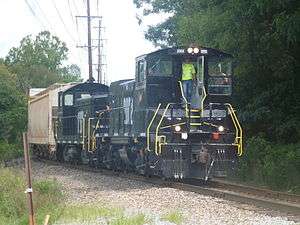
Rail freight in Knoxville is handled by two Class I railroads, CSX and Norfolk Southern, and one shortline, the Knoxville and Holston River Railroad. Railroads account for about 12% of the Knoxville area's outbound freight and 16% of the area's inbound freight.[163] The city has two major rail terminals: the Burkhart Enterprises terminal at the Forks of the River Industrial Park just east of the city, and the TransFlo facility adjacent to the U.T. campus.[163] Knoxville's two old passenger stations, the Southern Terminal and the L&N Station, now serve non-railroad functions.
Norfolk Southern, which controls about 210 miles (340 km) of tracks in the Knoxville area,[163] averages 35 freight trains through the city per day,[164] and operates a major classification yard, the John Sevier Yard, just east of the city. The company uses a small rail yard near the I-40/I-275 interchange in Downtown Knoxville for a staging area.[163] The Norfolk Southern system includes spur lines to the coal fields around Middlesboro, Kentucky, and the ALCOA plants in Blount County.[163]
CSX controls about 76 miles (122 km) of tracks in the Knoxville area, much of which is located along an important north-south line between Cincinnati and Louisville to the north and Chattanooga and Atlanta to the south.[163] Minor switching operations for CSX occur at the TransFlo facility near the U.T. campus.[163] The CSX system includes spur lines to TVA's Bull Run Fossil Plant and the Oak Ridge National Laboratory in Anderson County, and the ALCOA plants in Blount County.[163]
The Knoxville and Holston River Railroad (KXHR) is a subsidiary of Gulf and Ohio Railways, a shortline holding company headquartered at the James Park House in Downtown Knoxville. The KXHR operates a 19-mile (31 km) line between the Burkhart terminal at Forks of the River and the Coster Yard in North Knoxville, where the freight is transferred to CSX and Norfolk Southern lines or transloaded onto trucks.[163] The KXHR also manages the Knoxville Locomotive Works at the Coster Yard, and operates the Three Rivers Rambler, a tourist train that runs along the riverfront.[165]
Historic passenger service
Until the mid-20th century three railroads and their stations operated regular trains, serving points north, east, south and west: the Louisville and Nashville Railroad's L&N Station (last train operating there, 1968), the Smoky Mountain Railroad's station and the Southern Railway's Southern Terminal (last train operating there, 1970).
River transport
Knoxville is an international port connected via navigable channels to the nation's inland waterways and the Gulf of Mexico. The city's waterfront lies just under 700 river miles from the Mississippi River (via the Tennessee and Ohio rivers),[166] and just under 900 river miles from Mobile, Alabama, on the Gulf of Mexico (via the Tennessee River and Tennessee-Tombigbee Waterway).[167] TVA maintains a minimum 9-foot (2.7 m) channel on the entirety of the Tennessee River. The minimum size of locks on Tennessee River and Tennessee-Tombigbee Waterway dams is 600 feet (180 m) by 110 feet (34 m).[168]
Most commercial shipping on the Tennessee River is provided by barges, which deliver on average a half-million tons of cargo to Knoxville per year, mostly asphalt, road salt, and steel and coke.[169] Burkhart Enterprises operates the city's most active public barge terminal at its Forks of the River facility, handling approximately 350,000 tons of barge cargo per year.[169] Knoxville Barge and Chattanooga-based Serodino, Inc., provide barge shipping services to and from the city.
Recreational craft that frequent the river include small johnboats, fishing boats and yachts. Boat slips and a marina are located at Volunteer Landing in the Downtown area. The VOL Navy, a flotilla of several dozen boats, swarms the river during weeks when the U.T. football team plays at Neyland Stadium. Cruise lines operating in the city include the Volunteer Princess, a luxury yacht, and the Star of Knoxville, a paddlewheel riverboat.
Sister cities
Knoxville has seven sister cities as designated by Sister Cities International:[170]
References in popular culture
- The 1999 film October Sky was filmed in Knoxville as well as several counties in east Tennessee,[171]
- The 2000 film Road Trip was partially filmed at the University of Tennessee campus downtown.
- The film Box of Moonlight, starring John Turturro and Sam Rockwell, was filmed and takes place in and around Knoxville.
- The March 31, 1996 episode of The Simpsons, entitled Bart on the Road, features Bart and his friends renting a car and driving to Knoxville after finding a promotional brochure for the city's 1982 World's Fair.[172]
- Several scenes from the 2004 film The Heart Is Deceitful Above All Things were shot in Knoxville.[173][174]
Other references to Knoxville in literature and music include:
- "Suttree", a 1979 semi-autobiographical novel by Knoxville native Cormac McCarthy is set in the city.
- "Knoxville Courthouse Blues", Hank Williams, Jr., 1984.
- "The Ballad of Thunder Road", Robert Mitchum, 1957. Lyrics reference Knoxville's Bearden community.
- "The Knoxville Girl", first recorded in 1924. traditional Appalachian ballad.
- "Knoxville: Summer of 1915", Samuel Barber, 1947 voice & orchestra piece based on 1938 short prose by James Agee.
- "Satan is Busy In Knoxville," song recorded in 1930 by jazz singer Leola Manning[175]
- "Smoky Mountain Rain", Ronnie Milsap, 1980. Lyrics begin "Thumbed my way from LA back to Knoxville . . ."
- "The Man in the Overstuffed Chair," a short story by playwright Tennessee Williams, gives a brief description of the death of Williams' father, Cornelius, at a Knoxville hospital, and his subsequent burial at Old Gray Cemetery.[176]
- Swiss travel writer Annemarie Schwarzenbach visited Knoxville in the 1930s, and wrote an essay about the city, "Auf der Schattenseite von Knoxville," which was published in the December 1937 edition of the Swiss magazine, National Zeitung.[177]
- Pulitzer Prize-winning author Peter Taylor's last novel, In the Tennessee Country, refers to a "Knoxville cemetery" where the main character's grandfather (a fictitious politician) is buried. This may refer to Old Gray Cemetery, where Taylor's own grandfather, Governor Robert Love Taylor, was originally buried in 1912.[178]
- Twain, Mark. Life on the Mississippi, Chapter 40. Twain wrote about a gunfight in downtown Knoxville involving Joseph Mabry Jr., owner of the city's antebellum Mabry-Hazen House.
- Part of the 1915 Anne W. Armstrong novel, The Seas of God, takes place in a fictional town called "Kingsville," based on Knoxville.[179]
- Van Ryan, Jane. The Seduction of Miss Evelyn Hazen. The book chronicles the sensational lawsuit between Knoxville socialite Evelyn Hazen, granddaughter of Joseph Mabry, Jr., and her fiancée.
- "What I Need to Do", Kenny Chesney, 1999. Lyrics include the line ". . . maybe head up north to Knoxville, Tennessee . . ."
- "Waitin' on a Woman", Brad Paisley, 2008. Lyrics reference Knoxville's West Town Mall.
- Woman In Hiding, a 1949 film noir starring actress Ida Lupino, has multiple scenes that take place in Knoxville.[180]
- Steve Earle refers to Knoxville in his 1988 song, "Copperhead Road" from the eponymous album, and referenced it in "Oxycontin Blues" from his Washington Square Serenade album, 2007.
- The Felice Brothers refer to "fluttering a chinese fan in a "Knoxville Fashion" in their song "Wonderful Life", from their Felice Brothers album (2008).
- Dire Straits guitarist Mark Knopfler recorded a song entitled, "Daddy's Gone to Knoxville," on his 2002 solo album, The Ragpicker's Dream.
- David Madden's 1974 novel, Bijou, is set in a fictional city known as "Cherokee," based on Knoxville.[181]
- The first part of James Herman Robinson's 1950 autobiography, The Road Without Turning, takes place in Knoxville.
- "Knoxville Morning" are an Irish Folk Rock/Americana band. The Title track from their self-titled Debut album "On this Knoxville Morning" is written about a day and night spent in Knoxville.
- Bruce Willis' character in the 1994 movie Pulp Fiction refers to moving to Knoxville from Los Angeles and being on "Tennessee time". It is also the place where his great-grandfather bought his gold watch, an important plot point in the movie.
See also
Notes
- In 1915, 1921, 1990, and 2013, no day the entire year remained at or below freezing.[70]
- This contributed to the winter of 1959−60 being the snowiest on record, with a total of 56.7 in (144 cm). On the other extreme, five winters, most recently 2007−08, have recorded only a trace of snowfall.[70]
- Mean monthly maxima and minima (i.e. the expected highest and lowest temperature readings at any point during the year or given month) calculated based on data at said location from 1981 to 2010.
- Official records for Knoxville kept January 1871 to February 1942 at downtown and at McGhee Tyson Airport since March 1942. For more information, see Threadex
References
- Ask Doc Knox, "What's With All This Marble City Business?" Metro Pulse, May 10, 2010. Accessed at the Internet Archive, October 1, 2015.
- Lucile Deaderick, Heart of the Valley: A History of Knoxville, Tennessee (Knoxville, Tenn.: East Tennessee Historical Society, 1976).
- Mark Banker, Appalachians All: East Tennessee and the Elusive History of an American Region (Knoxville, Tenn.: University of Tennessee Press, 2010), p. 83.
- Jack Neely, From the Shadow Side: And Other Stories of Knoxville, Tennessee (Tellico Books, 2003).
- "Knoxvillians capitalize on the city's 'scruffy' reputation | The Daily Beacon". Archived from the original on April 10, 2015. Retrieved April 10, 2015.
- Jack Neely, "A Knoxville Vacation Archived October 15, 2015, at the Wayback Machine", Knoxville Mercury, July 9, 2015.
- "Knoxville". Municipal Technical Advisory Service. Retrieved August 5, 2020.
- "Government". City of Knoxville. Retrieved August 5, 2020.
- "2019 U.S. Gazetteer Files". United States Census Bureau. Retrieved July 30, 2020.
- "Feature Detail Report for: City of Knoxville". USGS. March 10, 2008. Retrieved January 15, 2009.
- "U.S. Census website". United States Census Bureau. Retrieved November 6, 2014.
- "Population and Housing Unit Estimates". Retrieved May 21, 2020.
- "U.S. Census website". United States Census Bureau. Retrieved January 31, 2008.
- "US Board on Geographic Names". United States Geological Survey. October 25, 2007. Archived from the original on February 26, 2012. Retrieved January 31, 2008.
- "Find a County". National Association of Counties. Archived from the original on May 31, 2011. Retrieved June 7, 2011.
- "U.S. Census Bureau QuickFacts: Knoxville city, Tennessee". www.census.gov.
- U.S. Census Bureau, 2010 Census Interactive Population Search Archived January 21, 2012, at the Wayback Machine. Retrieved: December 20, 2011.
- "Census: Nashville, Knoxville Areas Continue to Lead the State in Population Growth". Tennessee Today. March 23, 2017. Archived from the original on August 21, 2017. Retrieved August 20, 2017.
- W. Bruce Wheeler, "Knoxville Archived April 27, 2012, at the Wayback Machine." The Tennessee Encyclopedia of History and Culture, 2002. Retrieved: February 28, 2008.
- "Ask Doc Knox", "Downtown's Homegrown Revival", Metro Pulse, November 16, 2011. Accessed at the Internet Archive, October 1, 2015.
- King, Niki (December 12, 2011). "Urban Appalachia: Who, Where and What is it?!". The Hillville. Retrieved July 28, 2020.
Knoxville, Roanoke and Pittsburgh all had spots in Planetizen’s list of top 100 public spaces, an indication of the urban-loving lifestyles that flourish there.
- Harlan, Will (November 29, 2012). "Knoxville plans greenway to the Smokies". Blue Ridge Outdoors. Retrieved July 28, 2020.
Knoxville, the self-proclaimed “Gateway to the Smokies,” has big plans to build a greenway system that connects it to the country’s most popular national park.
- Fletcher Jolly III, "40KN37: An Early Woodland Habitation Site in Knox County, Tennessee", Tennessee Archaeologist 31, nos. 1–2 (1976), 51.
- Frank H. McClung Museum, "Woodland Period Archived April 12, 2012, at the Wayback Machine." Retrieved: March 25, 2008.
- James Strange, "An Unusual Late Prehistoric Pipe from Post Oak Island (40KN23)", Tennessee Archaeologist 30, no. 1 (1974), 80.
- Richard Polhemus, The Toqua Site—40MR6, Vol. I (Norris, Tenn.: Tennessee Valley Authority, 1987), 1240-1246.
- Cora Tula Watters, "Shawnee." The Encyclopedia of Appalachia (Knoxville, Tenn.: University of Tennessee Press, 2006), 278-279.
- Ima Stephens, "Creek", The Encyclopedia of Appalachia (Knoxville, Tenn.: University of Tennessee Press, 2006), 252-253.
- James Mooney, Myths of the Cherokee and Sacred Formulas of the Cherokee (Nashville: Charles Elder, 1972 - reprint from 1891 and 1900), 526.
- Jefferson Chapman, Tellico Archaeology: 12,000 Years of Native American History (Norris, Tenn.: Tennessee Valley Authority, 1985), 97.
- Henry Timberlake, Samuel Williams (ed.), Memoirs, 1756–1765 (Marietta, Georgia: Continental Book Co., 1948), 54.
- William MacArthur, Knoxville, Crossroads of the New South (Tulsa, Okla.: Continental Heritage Press, 1982), 1-15.
- Yong Kim, The Sevierville Hill Site: A Civil War Union Encampment on the Southern Heights of Knoxville, Tennessee (Knoxville, Tenn.: University of Tennessee Transportation Center, 1993), 9.
- Kim, The Sevierville Hill Site, 9.
- MacArthur, 17.
- William MacArthur, Jr., Knoxville: Crossroads of the New South (Tulsa, Oklahoma: Continental Heritage Press, 1982), 17-22.
- G. H. Stueckrath, "Incidents in the Early Settlement of East Tennessee and Knoxville Archived April 1, 2009, at the Wayback Machine." Originally published in De Bow's Review Vol. XXVII (October 1859), O.S. Enlarged Series. Vol. II, No. 4, N.S. Pages 407-419. Transcribed for web content by Billie McNamara, 1999–2002. Retrieved: February 25, 2008.
- MacArthur, Knoxville: Crossroads of the New South, 23.
- Jonathan Atkins, "Hugh Lawson White Archived July 2, 2017, at the Wayback Machine." The Tennessee Encyclopedia of History and Culture, 2002. Retrieved: February 26, 2008.
- Forrest Conklin, "William Gannaway "Parson" Brownlow Archived March 3, 2016, at the Wayback Machine." The Tennessee Encyclopedia of History and Culture, 2002. Retrieved: February 27, 2008.
- Durwood Dunn, Cades Cove: The Life and Death of An Appalachian Community (Knoxville: University of Tennessee Press, 1988), 125.
- Knoxville-Knox County Metropolitan Planning Commission, "Designated Properties: Knoxville Historic Zoning Commission Archived July 12, 2007, at the Wayback Machine." Retrieved: February 27, 2008.
- MacArthur, Knoxville: Crossroads of the New South, 42-44.
- Eric Lacy, Vanquished Volunteers: East Tennessee Sectionalism from Statehood to Secession (Johnson City, Tenn.: East Tennessee State University Press, 1965), pp. 217-233.
- Kim, The Sevierville Hill Site, 10.
- Kim, The Sevierville Hill Site, 10-12.
- Kim, The Sevierville Hill Site, 15-17.
- William Bruce Wheeler, "Knoxville, Tennessee." The Encyclopedia of Appalachia (Knoxville, Tenn.: University of Tennessee Press, 2006), 375.
- Linda Snodgrass, "The Candoro Marble Works Archived June 28, 2009, at the Wayback Machine." 2000. Retrieved: February 28, 2008.
- Found in Knoxville City Code of Ordinances Chapter 1, Section 1-12 www.knoxvilletn.gov/government/city_ordinances_charter
- "Statement as to the Adoption of the Knoxville City Flag", November 6, 1896, Knoxville Minute Book, Book L, p.380.
- Milton Klein, "University of Tennessee Archived August 30, 2011, at the Wayback Machine." The Tennessee Encyclopedia of History and Culture, 2002. Retrieved: February 28, 2008.
- Jack Neely, "Knoxville, Tennessee." The Encyclopedia of Appalachia (Knoxville, Tenn.: University of Tennessee Press, 2006), 654.
- Carlos Campbell, Birth of a National Park In the Great Smoky Mountains (Knoxville: University of Tennessee Press, 1969), 13-18, 32.
- W. Bruce Wheeler, "Tennessee Valley Authority Archived August 30, 2011, at the Wayback Machine." The Tennessee Encyclopedia of History and Culture, 2002. Retrieved: February 28, 2008.
- "Dew History". Archived from the original on May 17, 2008. Retrieved April 27, 2006.
- W. Bruce Wheeler, "Knoxville World's Fair of 1982 Archived April 27, 2012, at the Wayback Machine." The Tennessee Encyclopedia of History Culture, 2002. Retrieved: February 28, 2008.
- "Revitalizing Gay Street in Knoxville". Architects + Artisans. May 6, 2014. Retrieved August 3, 2020.
- "South Waterfront". City of Knoxville. Retrieved August 3, 2020.
- Marcum, Ed (September 19, 2016). "Rendering of new Regal headquarters in Knoxville released". Knoxville News Sentinel. Retrieved August 3, 2020.
- "First Creek". Geographic Names Information System. United States Geological Survey.
- "Cedar Bluff". Geographic Names Information System. United States Geological Survey.
- "Knoxville". Geographic Names Information System. United States Geological Survey.
- "Brown Mountain". Geographic Names Information System. United States Geological Survey.
- City of Knoxville, Sharp's Ridge Memorial Park History Archived May 1, 2011, at the Wayback Machine. Retrieved: December 29, 2011.
- Tennessee Department of Environment and Conservation, House Mountain Class I Scenic Recreational State Natural Area Archived January 12, 2012, at the Wayback Machine. Retrieved: December 29, 2011.
- "House Mountain". Geographic Names Information System. United States Geological Survey.
- NOAA Archived December 10, 2006, at the Wayback Machine, Mean Number of Days With Maximum Temperature 90 Degrees F or Higher.
- "NowData - NOAA Online Weather Data". National Oceanic and Atmospheric Administration. Archived from the original on November 16, 2018. Retrieved October 3, 2019.
- Lance Coleman, "Knoxville Having Hottest Day Ever at 105 Degrees Archived July 4, 2012, at the Wayback Machine", Knoxville News Sentinel, June 30, 2012. Retrieved: June 30, 2012.
- "Knoxville Climate Page". Archived from the original on March 4, 2016. Retrieved April 18, 2016.
- "Top 10 Snowfalls in Knoxville Archived July 3, 2014, at the Wayback Machine", Knoxville News Sentinel, February 12, 2014.
- "Station Name: TN KNOXVILLE MCGHEE TYSON AP". National Oceanic and Atmospheric Administration. Archived from the original on May 25, 2017. Retrieved April 23, 2014.
- "WMO Climate Normals for KNOXVILLE/MUNICIPAL, TN 1961–1990". National Oceanic and Atmospheric Administration. Retrieved March 10, 2014.
- Metropolitan and Micropolitan Statistical Areas Archived September 23, 2011, at the Wayback Machine, U.S. Census Bureau
- "Georgia Institute of Technology :: CQGRD : Piedmont Atlantic Megaregion (PAM)". Archived from the original on September 27, 2010.
- Jack Neely, "The Skies, The Limits", Metro Pulse, October 25, 2001. Accessed at the Internet Archive, October 1, 2015.
- Josh Flory, "Dean Trumps Comedian Stephen Colbert for Tower's Name Archived July 11, 2012, at the Wayback Machine", Knoxville News Sentinel, November 10, 2009. Retrieved: January 7, 2012.
- "Mayor Wants to Sell Downtown Building, Relocate Knox School Offices Archived March 7, 2012, at the Wayback Machine", WATE.com, June 5, 2007. Retrieved: January 7, 2012.
- Andrew Eder, "TVA Tower Gets Occupants Archived July 11, 2012, at the Wayback Machine", Knoxville News Sentinel, October 2, 2007. Retrieved: January 7, 2012.
- Sunsphere.info Archived March 9, 2012, at the Wayback Machine. Retrieved: January 7, 2007
- Amy McRary (May 28, 2016). "World's Fair: The world came to Knoxville in May 1982". The Knoxville News Sentinel. Archived from the original on July 3, 2016. Retrieved July 2, 2016.
- Knox Heritage, George Barber Homes Trolley Tour Booklet Archived July 26, 2011, at the Wayback Machine, 2007. Retrieved: January 7, 2012.
- City of Knoxville, Parks Archived August 24, 2011, at the Wayback Machine. Retrieved: January 7, 2012.
- City of Knoxville, Downtown North Redevelopment Archived May 13, 2012, at the Wayback Machine. Retrieved: January 7, 2012.
- "Census of Population and Housing: Decennial Censuses". United States Census Bureau. Retrieved March 4, 2012. Note: the 1860 census did not include a population estimate for Knoxville. See p. 467.
- "Table 43. Tennessee – Race and Hispanic Origin for Selected Large Cities and Other Places: Earliest Census to 1990" (PDF). U.S. Census Bureau. July 13, 2005. Retrieved April 27, 2018.
- "Knoxville city, Tennessee". United States Census Bureau. Retrieved December 29, 2019.
- "U.S. Census Bureau QuickFacts: Knoxville city, Tennessee". census.gov. United States Census Bureau. Retrieved July 18, 2020.
- U.S. Census Bureau, QuickFacts sheet for Knoxville (city), Tennessee Archived June 8, 2007, at the Wayback Machine. Retrieved: December 20, 2011.
- Jack Neely, "Knoxville By the (Census) Numbers", Metro Pulse, June 29, 2011. Accessed at the Internet Archive, October 1, 2015.
- U.S. Census Bureau, "Poverty - Highlights Archived December 24, 2011, at the Wayback Machine, September 13, 2011. Retrieved: December 21, 2011.
- Economic Research Institute, Inc., ERI Economic Research Institute Releases Survey on Best and Worst Cities for College Grads – Based on salary/cost of living, Knoxville, TN rated best Archived September 27, 2007, at the Wayback Machine, press release, July 6, 2006
- Erin Carlyle, "America's Most Affordable Cities Archived July 29, 2017, at the Wayback Machine", Forbes.com, March 11, 2014.
- "Crime in the United States by Metropolitan Statistical Area, 2017". Federal Bureau of Investigation. Archived from the original on February 6, 2019. Retrieved May 10, 2019.
- Knoxville-Knox County Metropolitan Planning Commission, Facts & Figures 2011 Archived May 11, 2012, at the Wayback Machine. Retrieved: January 14, 2012.
- "Best Value Cities 2011: 5. Knoxville, Tenn". www.kiplinger.com. Archived from the original on January 10, 2013. Retrieved April 18, 2016.
- "Hot Spots - Forbes.com". Forbes. April 7, 2008. Archived from the original on December 6, 2008.
- "Work". Archived from the original on November 19, 2014. Retrieved April 18, 2016.
- Innovation Valley Inc. - About Us Archived June 8, 2012, at the Wayback Machine. Retrieved: January 13, 2012.
- Frequently Asked Questions About TVA Archived January 13, 2012, at the Wayback Machine, TVA website. Retrieved: January 14, 2012.
- Andy Ashby, "TVA Revenue Rises Almost 9 Percent in Fiscal 2011 Archived December 19, 2011, at the Wayback Machine," Memphis Business Journal, November 18, 2011. Retrieved: January 14, 2012.
- "Perfect Storm Swamped TVA Retirement Plan Archived May 11, 2013, at the Wayback Machine," Chattanooga Times Free Press, February 20, 2010. Retrieved: January 14, 2012.
- Knoxville-Area Public Companies Ranked According to Revenue Archived February 5, 2012, at the Wayback Machine, Knoxville Book of Lists (Knoxville News Sentinel), 2012. Retrieved: January 14, 2012.
- "Eight Tennessee Companies on Fortune 500 List Archived July 11, 2012, at the Wayback Machine, Knoxville News Sentinel, April 21, 2009.
- America's Largest Private Companies - #6 Pilot Flying J Archived September 9, 2017, at the Wayback Machine, Forbes.com, 2013. Retrieved: October 10, 2013.
- America's Largest Private Companies - #103 HT Hackney Archived July 29, 2017, at the Wayback Machine, Forbes.com, 2012. Retrieved: October 10, 2013.
- Knoxville-Area Advertising Firms and Marketing Firms Archived February 14, 2012, at the Wayback Machine, Knoxville Book of Lists (Knoxville News Sentinel), 2012. Retrieved: January 14, 2012.
- Laura Bower Tombras Creates New Nationwide Impaired Driving Campaign for U.S. Department of Transportation: Drive Sober or Get Pulled Over Archived December 24, 2011, at the Wayback Machine. August 30, 2011.
- "MONEY: Personal Finance News & Advice". MONEY.com. Archived from the original on August 24, 2017. Retrieved September 2, 2017.
- Knox County Office Buildings Ranked According to Gross Square Footage Archived April 6, 2012, at the Wayback Machine, Knoxville Book of Lists (Knoxville News Sentinel), 2012. Retrieved: January 13, 2012.
- Knox County Industrial Parks Ranked According to Size Archived February 14, 2012, at the Wayback Machine, Knoxville Book of Lists (Knoxville News Sentinel), 2012. Retrieved: January 11, 2012.
- Knoxville Area Banks Ranked According to Local Deposits Archived April 6, 2012, at the Wayback Machine, Knoxville Book of Lists (Knoxville News Sentinel), 2012. Retrieved: January 11, 2012.
- Knoxville-Area Investment Brokerage Firms Archived March 24, 2012, at the Wayback Machine, Knoxville Book of Lists (Knoxville News Sentinel), 2012. Retrieved: January 11, 2012.
- Knox County Mortgage Lenders Ranked According to Dollar Volume Archived March 24, 2012, at the Wayback Machine, Knoxville Book of Lists (Knoxville News Sentinel), 2012. Retrieved: January 11, 2012.
- Knoxville-Area CPA Firms Ranked According to Number of Licensed CPAs Archived March 24, 2012, at the Wayback Machine, Knoxville Book of Lists (Knoxville News Sentinel), 2013. Retrieved: July 26, 2013.
- Knoxville-Oak Ridge Innovation Valley, [www.knoxvillechamber.com/pdf/demographics/MajorManufacturers.doc Top 50 Major Manufacturers in the Knoxville Area - 2009]. Retrieved: January 14, 2012.
- Knoxville-Area Major Manufacturers Archived March 24, 2012, at the Wayback Machine, Knoxville Book of Lists (Knoxville News Sentinel), 2012. Retrieved: January 14, 2012.
- Knoxville-Knox County Metropolitan Planning Commission, West City Sector Plan - Land Use and Development Archived March 6, 2012, at the Wayback Machine, August 9, 2007. Retrieved: December 1, 2010.
- About UT-Battelle Archived January 18, 2012, at the Wayback Machine. Retrieved: January 14, 2012.
- Knoxville-Area National Science Foundation Grants Archived March 24, 2012, at the Wayback Machine, Knoxville Book of Lists (Knoxville News Sentinel), 2012. Retrieved: January 14, 2012.
- "CURENT". Archived from the original on February 16, 2012. Retrieved April 18, 2016.
- Tennessee Technology Corridor Development Authority, Comprehensive Development Plan - 2008 Update Archived May 11, 2012, at the Wayback Machine. Retrieved: January 14, 2012.
- Roy C. Brewer, Symphony Orchestras Archived September 27, 2013, at the Wayback Machine, Tennessee Encyclopedia of History and Culture, December 25, 2009; last updated February 28, 2011; accessed: June 25, 2013.
- "History". Knoxville Opera. Archived from the original on September 13, 2018. Retrieved September 13, 2018.
- "Rachmaninoff's Last Concert - Memorial Statue dedicated to the famous Russian Composer". Archived from the original on April 27, 2016. Retrieved April 18, 2016.
- Jack Neely, "Knoxville's Ever-Changing Public Image," Metro Pulse, March 28, 2012. Accessed at the Internet Archive, October 5, 2015.
- Maria Carter, "Get Away to Knoxville Archived December 19, 2014, at the Wayback Machine," Atlanta, June 28, 2013.
- Moon Blue Ridge & Smoky Mountains - Page 279 1612380662 Deborah Huso - 2011 Christmas in the City (865/215-4248, www.cityofknoxville.org, Nov.–Dec.) covers eight weeks of festivities at various locations throughout the city. The activities include ... Santa, as well as ice skating on Knoxville's Holidays on Ice skating rink.
- "Knoxville's Holidays on Ice". Archived from the original on April 15, 2016. Retrieved April 18, 2016.
- Norma Polovitz Nickerson and Jake Jorgenson, Designated Market Areas: Using Zip Codes As a Marketing Tool Archived September 29, 2011, at the Wayback Machine. University of Montana Institute for Tourism and Recreation Research, April 2011. Retrieved: January 26, 2012.
- Knoxville-Area Television Stations Ranked According to Market Share Archived March 24, 2012, at the Wayback Machine, Knoxville Book of Lists (Knoxville News Sentinel), 2012. Retrieved: January 26, 2012.
- "About Scripps Networks". Scripps Networks Interactive. Archived from the original on June 30, 2011. Retrieved April 1, 2011.
- Arbitron Radio Market Rankings: Fall 2011 Archived October 16, 2010, at the Wayback Machine. Retrieved: January 26, 2012.
- Knoxville-Area Radio Stations Archived April 6, 2012, at the Wayback Machine, Knoxville Book of Lists (Knoxville News Sentinel), 2012. Retrieved: January 26, 2012.
- Barker, Scott (August 19, 2002). "Council lets mayor keep gavel - for now". The Knoxville News-Sentinel.
- Jennifer Meckles, "Madeline Rogero Sworn in as Mayor of Knoxville Archived February 9, 2013, at Archive.today," WBIR.com, December 17, 2011. Retrieved: December 20, 2011.
- "City Council". City of Knoxville. Archived from the original on September 7, 2008. Retrieved August 14, 2008.
- "KNOXVILLE FIRE DEPARTMENT (KFD)". Archived from the original on November 4, 2011. Retrieved December 2, 2011.
- "FIELD OPERATIONS". Archived from the original on January 21, 2012. Retrieved December 2, 2011.
- "Rural/Metro moves early to extend pact". Archived from the original on July 11, 2012. Retrieved December 2, 2011.
- "Mayors". City of Knoxville. Archived from the original on May 4, 2012. Retrieved May 8, 2017.
- East Tennessee Colleges and Universities Archived April 6, 2012, at the Wayback Machine, Knoxville Book of Lists (Knoxville News Sentinel), 2012. Retrieved: January 15, 2012.
- UTK - About the University Archived January 20, 2012, at the Wayback Machine. Retrieved: January 15, 2012.
- About Pellissippi State Archived February 7, 2012, at the Wayback Machine. Retrieved: January 15, 2012.
- About Johnson Archived January 28, 2012, at the Wayback Machine. Retrieved: January 15, 2012.
- Tennessee Higher Education Commission, Student Enrollment, Completion and Placement Report, FY 2009–10 - South College Archived October 13, 2011, at the Wayback Machine. Retrieved: January 15, 2012.
- Linda McCoy, New Knoxville College President Has Plan to Add Stability and Seek Reaccreditation Archived July 11, 2012, at the Wayback Machine, Knoxville News Sentinel, December 10, 2010. Retrieved: January 15, 2012.
- Virginia College. "Knoxville, TN Career College - Virginia College". Archived from the original on October 11, 2015. Retrieved April 18, 2016.
- Knox County Schools, Strategic Plan Results - Graduation Rate Archived July 18, 2012, at the Wayback Machine. Retrieved: January 20, 2012.
- Knoxville-Area Private Schools Ranked According to Enrollment Archived March 9, 2012, at the Wayback Machine, Knoxville Book of Lists (Knoxville News Sentinel), 2012. Retrieved: January 20, 2012.
- East Tennessee Hospitals Archived April 6, 2012, at the Wayback Machine, Knoxville Book of Lists (Knoxville News Sentinel), 2012. Retrieved: January 24, 2012.
- Knoxville-Area Ambulatory Surgical Treatment Centers Archived March 9, 2012, at the Wayback Machine, Knoxville Book of Lists (Knoxville News Sentinel), 2012. Retrieved: January 24, 2012.
- Knoxville-Area County Health Report Archived April 6, 2012, at the Wayback Machine, Knoxville Book of Lists (Knoxville News Sentinel), 2012. Retrieved: January 24, 2012.
- "Spotlight on Success: How Knoxville Dramatically Reduced Ozone Smog and Became a Cleaner, Healthier City". American Lung Association. Archived from the original on February 14, 2018. Retrieved February 14, 2018.
- KUB - Electricity Archived January 20, 2012, at the Wayback Machine, KUB website. Retrieved: January 24, 2012.
- Knoxville-Area Utilities Archived March 9, 2012, at the Wayback Machine, Knoxville Book of Lists (Knoxville News Sentinel), 2012. Retrieved: January 24, 2012.
- Knoxville Book of Lists - Knox Co.'s Busiest Roads Archived February 14, 2012, at the Wayback Machine, Knoxvillebiz.com (Knoxville News Sentinel), 2012. Retrieved: January 11, 2012.
- Knoxville Area Transit website Archived December 27, 2011, at the Wayback Machine. Retrieved: December 31, 2011.
- About McGhee Tyson Airport Archived December 15, 2012, at the Wayback Machine. Retrieved: December 31, 2011.
- FAA Master Report Record for DKX Archived January 25, 2012, at the Wayback Machine, July 2, 2009. Retrieved: December 31, 2011.
- Knoxville Regional Transportation Planning Organization, 2005–2030 Knoxville Regional Long Range Transportation Plan Update Archived January 21, 2012, at the Wayback Machine, 2007, pp. 51-53. Retrieved: December 31, 2011.
- Rebecca Ferrar, "Teaming With Possibilities: Norfolk Southern Partners with UT to Go Global Archived April 25, 2012, at the Wayback Machine," Knoxnews.com, January 15, 2006. Retrieved: December 31, 2011.
- Knoxville & Holston River Railroad Archived July 18, 2010, at the Wayback Machine. Retrieved: December 31, 2011.
- USGS topographical maps. The entirety of the Tennessee River (652 miles), plus 46 miles along the Ohio River to where it empties into the Mississippi.
- Richard Simms, "Huckleberry Finn is Alive and Well Archived May 10, 2013, at the Wayback Machine," Chattanooga Times-Free Press, November 27, 2008. The trip is 437 miles along the Tennessee River from Knoxville to the entrance of the Tennessee-Tombigbee Waterway (near Pickwick Landing Dam in Hardin County), 234 miles along the waterway to Demopolis, Alabama, and another 214 miles along Tombigbee and Mobile rivers to Mobile.
- Tennessee-Tombigbee Water - Tenn-Tom Quickfacts Archived January 23, 2012, at the Wayback Machine. Retrieved: January 1, 2012.
- Rebecca Ferrar, "Rollin' On the River Archived May 31, 2012, at the Wayback Machine," Knoxville News Sentinel, August 22, 2004. Retrieved: January 1, 2012.
- "Sister City Directory". Sister Cities International. Archived from the original on July 9, 2007. Retrieved April 1, 2011.
- Morrow, Terry (September 20, 2010). "'October Sky' cast & crew reunite in Oliver Springs". Knoxville News-Sentinel. Archived from the original on October 13, 2012. Retrieved April 1, 2011.
- "The Simpsons: "Bart on the Road" Episode". Knoxville News-Sentinel. May 31, 1996. Archived from the original on May 15, 2011. Retrieved April 1, 2011.
- Bruce Handy, "The Boy Who Cried Author Archived July 13, 2016, at the Wayback Machine," Vanity Fair, May 2006.
- Filmography Archived August 4, 2016, at the Wayback Machine, Visit Knoxville Film/Knox website. Retrieved: July 31, 2016.
- Lynn Point Records, The St. James Sessions Archived July 14, 2011, at the Wayback Machine. Retrieved: February 5, 2010.
- Tennessee Williams, "The Man In the Overstuffed Chair." Collected Stories (New York: New Directions Books, 1985), p. xvi.
- Jack Neely, From the Shadow Side: And Other Stories of Knoxville, Tennessee (Tellico Books, 2003), p. 24.
- Jack Neely, Knoxville's Secret History (Scruffy Books, 1995), pp. 56-7.
- M. Thomas Inge, Charles Reagan Wilson, et al., The New Encyclopedia of Southern Culture: Literature (University of North Carolina Press, 2008), p. 174.
- Neely, From the Shadow Side, p. 96.
- "The Mighty Metro Pulse Collection of Awesome Knoxville Lists," Metro Pulse, June 23, 2010. Accessed at the Internet Archive, October 1, 2015.
Further reading
- Barber, John W., and Howe, Henry. All the Western States and Territories, . . . (Cincinnati, Ohio: Howe's Subscription Book Concern, 1867). pp. 631–632.
- Carey, Ruth. "Change Comes to Knoxville." in These Are Our Voices: The Story of Oak Ridge 1942–1970, edited by James Overholt, Oak Ridge, Tennessee, 1987.
- Deaderick, Lucile, ed. Heart of the Valley—A History of Knoxville, Tennessee Knoxville: East Tennessee Historical Society, 1976.
- Jennifer Long; "Government Job Creation Programs-Lessons from the 1930s and 1940s" Journal of Economic Issues . Volume: 33. Issue: 4. 1999. pp 903+, a case study of Knoxville.
- Isenhour, Judith Clayton. Knoxville, A Pictorial History. (Donning Company, 1978, 1980).
- "Knoxville". The Tennessee Encyclopedia of History and Culture. Archived from the original on April 15, 2006. Retrieved March 14, 2006.
- McDonald, Michael, and Bruce Wheeler. Knoxville, Tennessee: Continuity and Change in an Appalachian City University of Tennessee Press, 1983. the standard academic history
- McKenzie, Robert Tracy. Lincolnites and Rebels: A Divided Town in the American Civil War (2009) on Knoxville excerpt and text search
- The Future of Knoxville's Past: Historic and Architectural Resources in Knoxville, Tennessee. (Knoxville Historic Zoning Commission, October 2006).
- Rothrock, Mary U., editor. The French Broad-Holston Country: A History of Knox County, Tennessee. (Knox County Historical Committee; East Tennessee Historical Society, 1946).
- Temple, Oliver P. East Tennessee and the Civil War (1899) 588pp online edition
- Wheeler, Bruce. "Knoxville, Tennessee: A Mountain City in the New South" (University of Tennessee Press, 2005).
External links
| Wikimedia Commons has media related to Knoxville, Tennessee. |
| Wikivoyage has a travel guide for Knoxville. |
| Wikisource has the text of a 1905 New International Encyclopedia article about Knoxville, Tennessee. |
